Paul van Yperen's Blog, page 426
March 8, 2014
Wolfgang Lukschy
German actor Wolfgang Lukschy (1905-1983) performed in theatre, film and television. Between 1940 and 1979, he made over 75 film and television appearances. Best known is his role as gangster lord in the classic Spaghetti Western Per un pugno di dollari/A Fistful of Dollars (Sergio Leone, 1964), starring Clint Eastwood.
German postcard by Film-Foto-Verlag, no. A 3704/1, 1941-1944. Photo: Binz, Berlin.
Gallant Lover
Wolfgang Lukschy was born in Berlin, Germany in 1905. He initially worked for several years as a apprentice process engraver (a graphic specialist), and later as a film copier.
In 1928, he took acting lessons from Paul Bildt and soon the 23 year old found work at various stages in Germany. Following an engagement at the Berlin Volksbühne, he performed in Stuttgart, Würzburg, Munich and Hanover. Eleven years later he returned to Berlin to perform at the Schiller Theatre.
In 1940 he played his first film role in Friedrich Schiller – Triumph eines Genies/Friedrich Schiller - Triumph of a genius (Herbert Maisch, 1940) with Horst Caspar as the 18th-century German playwright and blank-verse poet.
Till the end of the war only a few more film parts followed for Lukschy. He had a small part in the propaganda film Ohm Kruger/Uncle Kruger (Hans Steinhoff, 1941) in which Emil Jannings played South African politician Paul Kruger and his eventual defeat by the British during the Boer War.
He embodied the gallant lover in the excellent revue-film Die Frau meiner Träume/The woman of my dreams (Georg Jacoby, 1944) starring Marika Rökk . With this leading role in one of the first German films in colour, he reached the height of his popularity.
In 1944, he also had a supporting part in the drama Die Degenhardts/The Degenhardts (Werner Klingler, 1944). Heinrich George starred as Karl Degenhardt, the patriarch of a family in Lubeck, who leads his wife and five children through the opening stages of Second World War culminating in the Bombing of Lübeck on 28 March 1942 by the Royal Air Force. The film was part of a cycle of home front films produced in Germany during the war. Die Degenhardts was intended to fan anti-British sentiment and prepare Germans psychologically for the destruction of their cities by Allied bombing raids and invasions.
German postcard by Film-Foto-Verlag, no. A 3465/1, 1941-1944. Photo: Baumann / Ufa.
Shady Characters
After the Second World War, Wolfgang Lukschy operated both as a director and as an actor. He was still active in the theatre and in the cinema for the East-German studio Deutsche Film AG (DEFA).
In the early 1950s, he worked mainly in West-Germany. On stage he played about 500 times Professor Higgins in the musical My Fair Lady.
In the cinema he appeared in the charming remake of the famous children’s film Emil und die Detektive/Emil and the Detectives (Robert A. Stemmle, 1954) based on the famous novel by Erich Kästner, and in Heimatfilms like Das Mädchen vom Moorhof/The Girl from the Marsh Croft (Gustav Ucicky, 1958) featuring Maria Emo .
During the 1960s he starred in Edgar Wallace thrillers such as Die toten Augen von London/The Dead Eyes of London (Alfred Vohrer, 1961) and in Karl May Westerns including Old Surehand (Alfred Vohrer, 1965) featuring Stewart Granger .
Even in international films one could see him. He played Col. Gen. Alfred Jodl in the American war film The Longest Day (Bernhard Wicki a.o., 1962) and the gangster lord John Baxter in the classic Spaghetti Western Per un pugno di dollari/A Fistful of Dollars (Sergio Leone, 1964) alongside Clint Eastwood and Gian Maria Volonté (as John Wells).
In his film roles, he presented now mostly shady characters who hide their excessive ambition or their questionable past behind outward correctness.
His film career dropped off in the 1970s. Lukschy played in the crime series Tatort (1970) and other television dramas. One of Lukschys main activities was film synchronization. He was often the German voice of James Mason , Walter Matthau, Stewart Granger , Gregory Peck, John Wayne and others.
Wolfgang Lukschy died in 1983 in Berlin. He had three sons: Wolfgang, Stefan and Mathias-Michael. Stefan Lukschy (1948) works as a director.
Italian trailer Per un pugno di dollari/A Fistful of Dollars (1964). Source: Cineocchio (YouTube).
Sources: Thomas Staedeli (Cyranos), Wikipedia (German and English) and .
German postcard by Film-Foto-Verlag, no. A 3704/1, 1941-1944. Photo: Binz, Berlin.
Gallant Lover
Wolfgang Lukschy was born in Berlin, Germany in 1905. He initially worked for several years as a apprentice process engraver (a graphic specialist), and later as a film copier.
In 1928, he took acting lessons from Paul Bildt and soon the 23 year old found work at various stages in Germany. Following an engagement at the Berlin Volksbühne, he performed in Stuttgart, Würzburg, Munich and Hanover. Eleven years later he returned to Berlin to perform at the Schiller Theatre.
In 1940 he played his first film role in Friedrich Schiller – Triumph eines Genies/Friedrich Schiller - Triumph of a genius (Herbert Maisch, 1940) with Horst Caspar as the 18th-century German playwright and blank-verse poet.
Till the end of the war only a few more film parts followed for Lukschy. He had a small part in the propaganda film Ohm Kruger/Uncle Kruger (Hans Steinhoff, 1941) in which Emil Jannings played South African politician Paul Kruger and his eventual defeat by the British during the Boer War.
He embodied the gallant lover in the excellent revue-film Die Frau meiner Träume/The woman of my dreams (Georg Jacoby, 1944) starring Marika Rökk . With this leading role in one of the first German films in colour, he reached the height of his popularity.
In 1944, he also had a supporting part in the drama Die Degenhardts/The Degenhardts (Werner Klingler, 1944). Heinrich George starred as Karl Degenhardt, the patriarch of a family in Lubeck, who leads his wife and five children through the opening stages of Second World War culminating in the Bombing of Lübeck on 28 March 1942 by the Royal Air Force. The film was part of a cycle of home front films produced in Germany during the war. Die Degenhardts was intended to fan anti-British sentiment and prepare Germans psychologically for the destruction of their cities by Allied bombing raids and invasions.
German postcard by Film-Foto-Verlag, no. A 3465/1, 1941-1944. Photo: Baumann / Ufa.
Shady Characters
After the Second World War, Wolfgang Lukschy operated both as a director and as an actor. He was still active in the theatre and in the cinema for the East-German studio Deutsche Film AG (DEFA).
In the early 1950s, he worked mainly in West-Germany. On stage he played about 500 times Professor Higgins in the musical My Fair Lady.
In the cinema he appeared in the charming remake of the famous children’s film Emil und die Detektive/Emil and the Detectives (Robert A. Stemmle, 1954) based on the famous novel by Erich Kästner, and in Heimatfilms like Das Mädchen vom Moorhof/The Girl from the Marsh Croft (Gustav Ucicky, 1958) featuring Maria Emo .
During the 1960s he starred in Edgar Wallace thrillers such as Die toten Augen von London/The Dead Eyes of London (Alfred Vohrer, 1961) and in Karl May Westerns including Old Surehand (Alfred Vohrer, 1965) featuring Stewart Granger .
Even in international films one could see him. He played Col. Gen. Alfred Jodl in the American war film The Longest Day (Bernhard Wicki a.o., 1962) and the gangster lord John Baxter in the classic Spaghetti Western Per un pugno di dollari/A Fistful of Dollars (Sergio Leone, 1964) alongside Clint Eastwood and Gian Maria Volonté (as John Wells).
In his film roles, he presented now mostly shady characters who hide their excessive ambition or their questionable past behind outward correctness.
His film career dropped off in the 1970s. Lukschy played in the crime series Tatort (1970) and other television dramas. One of Lukschys main activities was film synchronization. He was often the German voice of James Mason , Walter Matthau, Stewart Granger , Gregory Peck, John Wayne and others.
Wolfgang Lukschy died in 1983 in Berlin. He had three sons: Wolfgang, Stefan and Mathias-Michael. Stefan Lukschy (1948) works as a director.
Italian trailer Per un pugno di dollari/A Fistful of Dollars (1964). Source: Cineocchio (YouTube).
Sources: Thomas Staedeli (Cyranos), Wikipedia (German and English) and .
Published on March 08, 2014 23:00
March 7, 2014
Lucienne Chevert
Photographer Lucienne Chevert (1911-1982) portrayed dozens of French stars of the post-war period. She was an associate of the famous French photographer Sam Lévin.
Françoise Arnoul . French postcard by Editions P.I., Paris, no. 366. Photo: Lucienne Chevert.
Martine Carol . French postcard by Editions P.I., no. 210 H. Photo: Lucienne Chevert, no. 456.
Jeanne Moreau . French postcard by Editions du Globe (E.D.U.G.), no. 620. Photo: Lucienne Chevert.
Assistant and Associate
Information on Lucienne Chevert is hard to find, but we know the year when she was born: 1911.
In 1934, upcoming photographer Sam Lévin started his own photo studio in Paris and the young Lucienne Chevert became his assistant.
Chevert was only 22 or 23 at the time, but their cooperation at this portrait studio would continue till her death in 1982. Although Lévin was married with another woman, their professional association obviously worked.
In 1935 Sam Lévin was asked to replace a sick photographer at a film set. This proved to be a great start for a career as a set photographer for both him and Chevert.
Chevert is first credited as a set photographer for Dernier atout/The last ace (Jacques Becker, 1942) starring Mireille Balin and Raymond Rouleau. Reportedly a mediocre crime film.
During the French occupation she also made the stills for such films as Sortilèges (Christian-Jaque, 1944), Boule de suif (Christian-Jaque, 1945) with Micheline Presle , and Adieu chérie/Goodbye Darling (Raymond Bernard, 1945) with Danielle Darrieux .
Suzy Delair . French postcard by Editions du Globe, Paris, no. 128. Photo: Lucienne Chevert.
Bernard Blier. French postcard by Editions P.I., Paris, no. 369. Offered by Les Carbones Korès. Photo: Lucienne Chevert.
Simone Renant . French postcard by Editions du Globe, no. 153. Photo: Lucienne Chevert.
Lesbian Photographer
Very successful was Lucienne Chevert's cooperation with famous film director Henri-Georges Clouzot. It started with Quai des Orfèvres/Quay of the Goldsmiths (Henri-Georges Clouzot, 1947) for which she made beautiful star portraits of Louis Jouvet , Bernard Blier, Suzy Delair and Simone Renant .
Renant plays the photographer Dora, who works for the artists of the music halls and night clubs. One of her clients is her neighbour, the singer Jenny Lamour (Delair). It's clear by the way Dora interacts with Jenny that she is a lesbian and thus Dora is one of the first gay characters in the cinema.
Chevert of course made Dora's beautiful photos of Jenny Lamour, who were also used in the publicity for the film. Quai des Orfèvres is an excellent film noir with crisp black and white cinematography by Armand Thirard. Chevert gave her stills the same atmosphere. They are now popular items at auctions.
Next Lucienne Chevert made the stills for the comedy Antoine et Antoinette/Antoine and Antoinette (Jacques Becker, 1947) and Le dessous des cartes/Under the Cards (André Cayatte, 1948) starring Madeleine Sologne .
Her definitive breakthrough came with her work for the classic La salaire de la peur/The wages of fear (Henri-Georges Clouzot, 1952) with Yves Montand . La salaire de la peur is a painfully riveting suspense thriller about a suicidally dangerous mission involving trucks and nitroglycerine.
Yves Montand . French postcard by Editions P.I., Paris, no. 455. Photo: Lucienne Chevert.
Ingrid Bergman . French postcard by Editions du Globe, Paris, no. 198. Photo: Lucienne Chevert.
Dominique Wilms . French postcard by Editions P.I., Paris, no. 28G. Photo: Lucienne Chevert.
Beautiful and Sexy Stars
Lucienne Chevert is now only remembered for her set photography but also for her film star portraits. She became one of the most famous celebrity photographers in France and her glamorous portraits of film French actors and especially actresses graced thousands of European film star postcards.
In the intimacy of their beautifully decorated studio and thanks to her friendly character and personal interest, many film stars felt at ease. Her portraits of beautiful and sexy stars as Martine Carol and Françoise Arnoul are exquisite.
She made portraits of many stars of the French cinema of the 1950s, including Charles Aznavour , Eddie Constantine and Yves Montand . International stars like Ingrid Bergman and Nadja Tiller also posed for her camera.
Chevert photographed the faces of the Nouvelle Vague, like Jean-Paul Belmondo and Jeanne Moreau . Her colour portraits at that time are still fresh and cheerful. And in 1965, she returned to set photography for Agnes Varda’s classic Le Bonheur (1965).
Le Bonheur was one of her last known professional activities. Lucienne Chevert died in 1982.
Jean-Paul Belmondo French postcard by E.D.U.G., no. 77. Photo: Lucienne Chevert.
Juliette Mayniel . French postcard by EDUG (Editions du Globe), no. 45. Photo: Lucienne Chevert.
Jean Sorel . French postcard by E.D.U.G., no. 143. Photo: Lucienne Chevert.
This is the ninth post in a series on film star photographers. Earlier posts were on the Reutlinger Studio in Paris, Italian star photographer Attilio Badodi, the German photographer Ernst Schneider, Dutch photo artist Godfried de Groot, Milanese photographers Arturo Varischi and Giovanni Artico, the French Studio Lorelle, the British 'royal' photographer Dorothy Wilding, and last week: Berlin duo Becker & Maass.
Sources: UniFrance Films, Wikipedia, and .
Françoise Arnoul . French postcard by Editions P.I., Paris, no. 366. Photo: Lucienne Chevert.
Martine Carol . French postcard by Editions P.I., no. 210 H. Photo: Lucienne Chevert, no. 456.
Jeanne Moreau . French postcard by Editions du Globe (E.D.U.G.), no. 620. Photo: Lucienne Chevert.
Assistant and Associate
Information on Lucienne Chevert is hard to find, but we know the year when she was born: 1911.
In 1934, upcoming photographer Sam Lévin started his own photo studio in Paris and the young Lucienne Chevert became his assistant.
Chevert was only 22 or 23 at the time, but their cooperation at this portrait studio would continue till her death in 1982. Although Lévin was married with another woman, their professional association obviously worked.
In 1935 Sam Lévin was asked to replace a sick photographer at a film set. This proved to be a great start for a career as a set photographer for both him and Chevert.
Chevert is first credited as a set photographer for Dernier atout/The last ace (Jacques Becker, 1942) starring Mireille Balin and Raymond Rouleau. Reportedly a mediocre crime film.
During the French occupation she also made the stills for such films as Sortilèges (Christian-Jaque, 1944), Boule de suif (Christian-Jaque, 1945) with Micheline Presle , and Adieu chérie/Goodbye Darling (Raymond Bernard, 1945) with Danielle Darrieux .
Suzy Delair . French postcard by Editions du Globe, Paris, no. 128. Photo: Lucienne Chevert.
Bernard Blier. French postcard by Editions P.I., Paris, no. 369. Offered by Les Carbones Korès. Photo: Lucienne Chevert.
Simone Renant . French postcard by Editions du Globe, no. 153. Photo: Lucienne Chevert.
Lesbian Photographer
Very successful was Lucienne Chevert's cooperation with famous film director Henri-Georges Clouzot. It started with Quai des Orfèvres/Quay of the Goldsmiths (Henri-Georges Clouzot, 1947) for which she made beautiful star portraits of Louis Jouvet , Bernard Blier, Suzy Delair and Simone Renant .
Renant plays the photographer Dora, who works for the artists of the music halls and night clubs. One of her clients is her neighbour, the singer Jenny Lamour (Delair). It's clear by the way Dora interacts with Jenny that she is a lesbian and thus Dora is one of the first gay characters in the cinema.
Chevert of course made Dora's beautiful photos of Jenny Lamour, who were also used in the publicity for the film. Quai des Orfèvres is an excellent film noir with crisp black and white cinematography by Armand Thirard. Chevert gave her stills the same atmosphere. They are now popular items at auctions.
Next Lucienne Chevert made the stills for the comedy Antoine et Antoinette/Antoine and Antoinette (Jacques Becker, 1947) and Le dessous des cartes/Under the Cards (André Cayatte, 1948) starring Madeleine Sologne .
Her definitive breakthrough came with her work for the classic La salaire de la peur/The wages of fear (Henri-Georges Clouzot, 1952) with Yves Montand . La salaire de la peur is a painfully riveting suspense thriller about a suicidally dangerous mission involving trucks and nitroglycerine.
Yves Montand . French postcard by Editions P.I., Paris, no. 455. Photo: Lucienne Chevert.
Ingrid Bergman . French postcard by Editions du Globe, Paris, no. 198. Photo: Lucienne Chevert.
Dominique Wilms . French postcard by Editions P.I., Paris, no. 28G. Photo: Lucienne Chevert.
Beautiful and Sexy Stars
Lucienne Chevert is now only remembered for her set photography but also for her film star portraits. She became one of the most famous celebrity photographers in France and her glamorous portraits of film French actors and especially actresses graced thousands of European film star postcards.
In the intimacy of their beautifully decorated studio and thanks to her friendly character and personal interest, many film stars felt at ease. Her portraits of beautiful and sexy stars as Martine Carol and Françoise Arnoul are exquisite.
She made portraits of many stars of the French cinema of the 1950s, including Charles Aznavour , Eddie Constantine and Yves Montand . International stars like Ingrid Bergman and Nadja Tiller also posed for her camera.
Chevert photographed the faces of the Nouvelle Vague, like Jean-Paul Belmondo and Jeanne Moreau . Her colour portraits at that time are still fresh and cheerful. And in 1965, she returned to set photography for Agnes Varda’s classic Le Bonheur (1965).
Le Bonheur was one of her last known professional activities. Lucienne Chevert died in 1982.
Jean-Paul Belmondo French postcard by E.D.U.G., no. 77. Photo: Lucienne Chevert.
Juliette Mayniel . French postcard by EDUG (Editions du Globe), no. 45. Photo: Lucienne Chevert.
Jean Sorel . French postcard by E.D.U.G., no. 143. Photo: Lucienne Chevert.
This is the ninth post in a series on film star photographers. Earlier posts were on the Reutlinger Studio in Paris, Italian star photographer Attilio Badodi, the German photographer Ernst Schneider, Dutch photo artist Godfried de Groot, Milanese photographers Arturo Varischi and Giovanni Artico, the French Studio Lorelle, the British 'royal' photographer Dorothy Wilding, and last week: Berlin duo Becker & Maass.
Sources: UniFrance Films, Wikipedia, and .
Published on March 07, 2014 23:00
March 6, 2014
Gudrun Hildebrandt
Gudrun Hildebrandt was a well-known German dance artist, who also appeared in a few silent films. Although she was one of the most photographed artists of her time and there are dozens of postcards of Hildebrandt, she seems forgotten now.
German postcard by P.M.B., no. 4526/1.
German postcard by GL Co., no. 4114/6. Sent by mail in 1910.
Beautiful Dancer
It is quite hard to find information about Gudrun Hildebrandt on the net. This is what we found:
Gudrun was the daughter of a journalist, who worked for Kaiser Wilhelm II. He purchased all the gifts for the Kaiser. Her father was Jewish, but christened as a baby.
As an adult, Gudrun danced to the music of Chopin in theatrical productions and performed in productions as Wolk und Wind (Cloud and Wind).
The beautiful dancer became a popular subject for dozens of postcards. It was a logical step to the cinema.
According to IMDb , Gudrun Hildebrandt appeared in only two films. Under the lemma Gudrun Hildebrand you can find Das Leben ein Roman/Life is a Novel (1913). Produced by Alfred Duskes for Duskes Kinematographen- und Film-Fabriken GmbH and directed by Carl Bernhardt.
Under ‘Gudrun Hildebrandt’ we found the short comedy Fräulein Puppe - Meine Frau/Miss Doll - My wife (1914) about a puppet which comes to life. This is an Uranus-Film-Gesellschaft Franz Scholling & Co production directed by the Polish director Danny Kaden (a.k.a. Nunek Danuky), and produced by Franz Scholling. Hildebrandt played the title character and the cast also included Kurt Gerron, Hermann Picha and Fritz Schulz .
The German Early Cinema Database gives a third title: Zwischen den Jahrhunderten/Between the centuries (1916), a production by Luna Film. This site also gives a description of the manuscript by Carl Schönfeld for Das Leben ein Roman: “A foster child is chased away. An earl takes her in. When his son is going to marry, she takes poison, but not enough.”
German postcard, no. 1445/46.
German postcard by EAS, no. 5 / 1899.
A Bourgeois Lifestyle Interrupted
Around 1920, Gudrun Hildebrandt had a dance school in Berlin and she published the book Grammatik der Modernen Tänze (Grammatics of modern dance). She also published in dance magazines.
In 1926 she published a novel under the title Steffi Walborg, der Roman einer Tänzerin (Steffi Walborg, the novel of a dancer).
In her book, Frenchy: I Wanted to Get Back at Hitler, Tracy L. Shaler relates the life of a niece of Hildebrandt, Jeannette Grünfeld Marx, and gives also information about Hildebrandt.
Gudrun was married to Grünfeld’s uncle, Benjamin (or Benedikt) Marx, a successful businessman and an elected member of the Social Democratic Party.
In 1930 their bourgeois lifestyle was interrupted by the elections when the Nazi party won 107 seats in the Reichstag. Benedikt and Gudrun fled Germany shortly before Hitler was made Reichs Chancellor.
What later happened with Gudrun Hildebrandt is unclear to us. How was her later life in England? Where and when did she die? If you know the answers, please send a mail and share the info.
German postcard, no. 1381/82.
German postcard by Bromüra, no. B 238.
German postcard by Rotophot, no. 1381/82. Sent by mail in 1909.
Sources: Tracy L. Shaler (Frenchy: I Wanted to Get Back at Hitler), The German Early Cinema Database, and .
German postcard by P.M.B., no. 4526/1.
German postcard by GL Co., no. 4114/6. Sent by mail in 1910.
Beautiful Dancer
It is quite hard to find information about Gudrun Hildebrandt on the net. This is what we found:
Gudrun was the daughter of a journalist, who worked for Kaiser Wilhelm II. He purchased all the gifts for the Kaiser. Her father was Jewish, but christened as a baby.
As an adult, Gudrun danced to the music of Chopin in theatrical productions and performed in productions as Wolk und Wind (Cloud and Wind).
The beautiful dancer became a popular subject for dozens of postcards. It was a logical step to the cinema.
According to IMDb , Gudrun Hildebrandt appeared in only two films. Under the lemma Gudrun Hildebrand you can find Das Leben ein Roman/Life is a Novel (1913). Produced by Alfred Duskes for Duskes Kinematographen- und Film-Fabriken GmbH and directed by Carl Bernhardt.
Under ‘Gudrun Hildebrandt’ we found the short comedy Fräulein Puppe - Meine Frau/Miss Doll - My wife (1914) about a puppet which comes to life. This is an Uranus-Film-Gesellschaft Franz Scholling & Co production directed by the Polish director Danny Kaden (a.k.a. Nunek Danuky), and produced by Franz Scholling. Hildebrandt played the title character and the cast also included Kurt Gerron, Hermann Picha and Fritz Schulz .
The German Early Cinema Database gives a third title: Zwischen den Jahrhunderten/Between the centuries (1916), a production by Luna Film. This site also gives a description of the manuscript by Carl Schönfeld for Das Leben ein Roman: “A foster child is chased away. An earl takes her in. When his son is going to marry, she takes poison, but not enough.”
German postcard, no. 1445/46.
German postcard by EAS, no. 5 / 1899.
A Bourgeois Lifestyle Interrupted
Around 1920, Gudrun Hildebrandt had a dance school in Berlin and she published the book Grammatik der Modernen Tänze (Grammatics of modern dance). She also published in dance magazines.
In 1926 she published a novel under the title Steffi Walborg, der Roman einer Tänzerin (Steffi Walborg, the novel of a dancer).
In her book, Frenchy: I Wanted to Get Back at Hitler, Tracy L. Shaler relates the life of a niece of Hildebrandt, Jeannette Grünfeld Marx, and gives also information about Hildebrandt.
Gudrun was married to Grünfeld’s uncle, Benjamin (or Benedikt) Marx, a successful businessman and an elected member of the Social Democratic Party.
In 1930 their bourgeois lifestyle was interrupted by the elections when the Nazi party won 107 seats in the Reichstag. Benedikt and Gudrun fled Germany shortly before Hitler was made Reichs Chancellor.
What later happened with Gudrun Hildebrandt is unclear to us. How was her later life in England? Where and when did she die? If you know the answers, please send a mail and share the info.
German postcard, no. 1381/82.
German postcard by Bromüra, no. B 238.
German postcard by Rotophot, no. 1381/82. Sent by mail in 1909.
Sources: Tracy L. Shaler (Frenchy: I Wanted to Get Back at Hitler), The German Early Cinema Database, and .
Published on March 06, 2014 23:00
March 5, 2014
Samy Frey
Esteemed and good-looking French actor Samy Frey (1937) (or Sami Frey) is best known for playing eccentric, offbeat roles in Nouvelle Vague films such as Jean Luc Godard's Bande à part/Band of Outsiders (1964). He also appeared in the provocative art-house classics Sweet Movie (1974) and Pourquoi pas!/Why not! (1977).

French postcard by Editions Marion Valentine, Paris, no. 244. Photo: Jean Mounicq. Samy Frey and La maja desnuda (The nude Maja) by Francisco Goya in 1963.
Young and Very Handsome
Samy Frey (sometimes credited as Sami Frey or Sammy Frey) was born Samuel Frei in Paris in 1937. He is of Polish Jewish descent.
He was in his late teens when he made his screen debut with an uncredited part in Napoléon (Sacha Guitry, 1955). This was followed by small parts in Pardonnez nos Offences/Forgive us our trespasses ( Robert Hossein , 1956) starring Marina Vlady , and the crime drama Les jeux dangereux/Dangerous games (Pierre Chenal, 1958), starring Jean Servais and Pascale Audret .
The young and very handsome Frey was soon engaged to Audret. Then he became the lover of Brigitte Bardot when he co-starred with her in La Vérité/The Truth (Henri-Georges Clouzot, 1960). The film was nominated for the Academy Award for Best Foreign Language Film.
Frey became known with Nouvelle Vague films like the short Les fiancés du pont Mac Donald (ou Méfiez-vous des lunettes noires)/The Lovers of Mac Donald bridge (or Beware of dark sunglasses) (Agnes Varda, 1961), the classic Cléo de 5 à 7/Cleo from 5 to 7 (Agnes Varda, 1962) featuring Corinne Marchand, and especially with Bande à part/Band of Outsiders (Jean Luc Godard, 1964). The latter is one of Godard's most accessible films and co-stars Anna Karina and Claude Brasseur.
Louis Schwartz at AllMovie : “Bande à part is driven by its actors and the chemistry among them. It uses their interactions to document the feeling of being young and French in the early 1960s.”
Acclaimed is also Thérèse Desqueyroux (Georges Franju, 1962) featuring Emmanuelle Riva . He then worked with expatriate American photographer and filmmaker William Klein at Qui êtes vous, Polly Maggoo?/Who Are You, Polly Maggoo? (William Klein, 1966), a satirical art house film spoofing the fashion world and its excesses.
Frey also worked on more mainstream films like the French historical romantic adventure Angélique et le Roy/Angelique and the King (Bernard Borderie, 1966), the third film of the Angelique series featuring Michèle Mercier . With Catherine Deneuve , he co–starred in Manon 70 (Jean Aurel, 1968), based on Manon Lescaut, an 18th-century French novel by Antoine François Prévost.
He reunited with William Klein for the anti-imperialist satirical farce Mr. Freedom (William Klein, 1969), starring Delphine Seyrig. She became his life partner till her death.
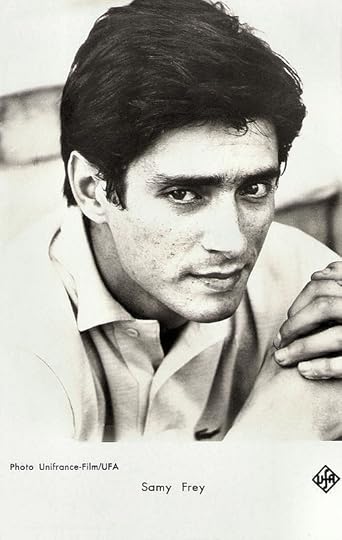
French postcard by Editions P.I., Paris, offered by Korès, no. FK 60 A. Photo: Unifrance Film / Ufa.
Sweet Movie
Sami Frey continued to make both art house productions and mainstream films. A small and little seen but also interesting film is Jaune le soleil/Yellow Sun (Marguerite Duras, 1971), an adaptation of Duras' novel Abahn Sabana David. Frey also co-starred with Yves Montand and Romy Schneider in the successful romance César et Rosalie/César and Rosalie (Claude Sautet, 1972).
A scandal was caused by the avant-garde comedy-drama Sweet Movie (1974), directed by Yugoslavian film maker Dušan Makavejev. The film created a storm of controversy upon its release, with simulated (and unsimulated) scenes of coprophilia (sexual pleasure from faeces), emetophilia (sexual arousement by vomiting or observing others vomit), fondling, and footage of remains of the Polish Katyn Massacre victims.
Sweet Movie was banned in many countries, or severely cut; it is still banned in many countries to this day. However, Richard Winters at IMDb calls the film ‘Uniquely Brilliant and Original’: “Unfairly labeled as excessive and perverse, this film is really a very fascinating, intricate study into the recesses of the sexual mind. It looks at sex in all its complexities. It exposes it as a very primal need. It also shows how the sexual side of the person can have a personality all of its own.”
AllMovie : “Love it or hate it, one can't help but admire the visionary Makavejev for pushing the medium as far as he possibly could, and doing so with a stunningly graceful technique.”
Also odd but interesting is Le jardin qui bascule/The Garden That Tilts (Guy Gilles, 1975) in which he appeared with his partner Delphine Seyrig. One of my personal favorites is the comedy-drama Pourquoi pas!/Why not! (Coline Serreau, 1977), about a marriage à trois.
Frey co-starred again with Catherine Deneuve in Écoute voir…/See Here My Love (Hugo Santiago, 1979). He had a supporting part in the successful thriller Mortelle Randonnée/ Deadly Circuit (Claude Mille, 1983) starring Michel Serrault and Isabelle Adjani .
He then played a PLO bomber opposite Diane Keaton in the American spy-film The Little Drummer Girl (George Roy Hill), adapted from the 1983 novel The Little Drummer Girl by John le Carré. Another international production was the thriller Black Widow (Bob Rafelson, 1987) starring Debra Winger and Theresa Russell.
In Germany he made the drama Laputa (Helma Sanders-Brahms, 1986), screened in the Un Certain Regard section at the 1986 Cannes Film Festival. In Belgium he made L'Œuvre au noir/The Abyss (André Delvaux, 1988) which was shown at the 1988 Cannes Film Festival. The drama, starring Gian Maria Volonté, is based on the novel by Marguerite Yourcenar.
Frey also appeared in the American miniseries War and Remembrance (Dan Curtis, 1988), the sequel to the highly successful series The Winds of War.
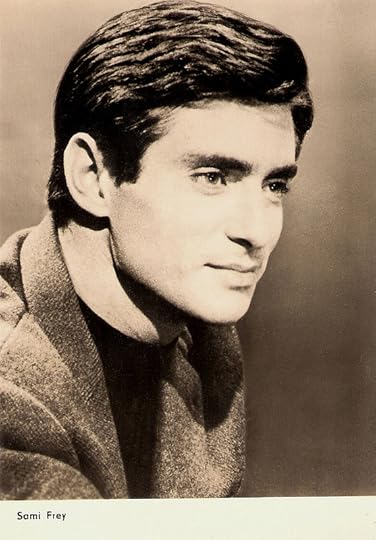
East-German postcard by VEB Progress Film-Vertrieb, Berlin, no. 2770, 1967. Retail price: 0,20 DM. Photo: Progress.
Antonin Artaud
In the 1990s and after, Sami Frey continued to star in several major European productions. He played the male lead in L'africana/The African Woman (Margarethe von Trotta, 1990) starring Stefania Sandrelli and Barbara Sukowa.
He was the narrator of the semi-autobiographical comedy Hors Saison/Off Season (1992) by Daniel Schmid, who re-imagines the hotel he grew up in the Swiss Alps, hosting a series of interesting guests, including the actress Sarah Bernhardt (Marisa Paredes), and an anarchist assassin ( Geraldine Chaplin ). The film was the Swiss submission for the Academy Award for Best Foreign Language Film.
Frey portrayed French actor, poet and playwright Antonin Artaud in En compagnie d'Antonin Artaud/My Life and Times with Antonin Artaud (Gérard Mordillat, 1993). For this role he garnered considerable critical acclaim. Oslo Jargo at IMDb : “Sami Frey, who plays Artaud, is simply extraordinary and there is no hint that this man is an actor, this man IS Artaud, everything he says, whether it be random missives on the nature of evil in a fly or movements with his hands, eyes and intense caricature of the face, realizes Artaud's living frenzy.”
That same year, Frey was also Aramis in the French adventure film La fille de d'Artagnan/Revenge of the Musketeers (Bertrand Tavernier, 1994). Sophie Marceau starred as the daughter of the renowned swordsman D'Artagnan who keeps the spirit of the Musketeers alive by bringing together the aging members of the legendary band to oppose a plot to overthrow the King and seize power.
Later films include the French drama Les menteurs/The Liars (Élie Chouraqui, 1996) with Jean-Hugues Anglade .
In the new century Frey kept appearing in major parts in European films. In Germany he starred in PiperMint... das Leben möglicherweise/PiperMint… life possibly (Nicole-Nadine Deppé, 2004) with Meret Becker. He co-starred with Sophie Marceau and Yvan Attal in the romantic thriller Anthony Zimmer (Jérôme Salle, 2005).
In Italy, he co-starred with Sergio Castellito in Il regista di matrimoni/The Wedding Director (Marco Bellocchio, 2006) which was screened in the Un Certain Regard section at the 2006 Cannes Film Festival. Also interesting is Nuit de chien/ This Night (Werner Schroeter, 2008), as offbeat as his Nouvelle Vague films.
Most recently, Sami Frey played the lead in Le nez dans le ruisseau/The nose in the stream (Christophe Chevalier, 2012). He played a philosophy professor, who strikes up a friendship with a 12-year-old boy who understands Rousseau's philosophy better than he, without ever having been exposed to it.
Trailer La Vérité/The Truth (1960). Source: Milibbardot (YouTube).
Scene from Bande à part/Band of Outsiders (1964). Source: Lalvolution (YouTube).
Trailer for Sweet Movie (1974). Source: GardenSceneEvenings (YouTube).
Sources: Louis Schwartz (AllMovie), Richard Winters (IMDb), Oslo Jargo (IMDb), Sandra Brennan (AllMovie), AllMovie, Wikipedia and .

French postcard by Editions Marion Valentine, Paris, no. 244. Photo: Jean Mounicq. Samy Frey and La maja desnuda (The nude Maja) by Francisco Goya in 1963.
Young and Very Handsome
Samy Frey (sometimes credited as Sami Frey or Sammy Frey) was born Samuel Frei in Paris in 1937. He is of Polish Jewish descent.
He was in his late teens when he made his screen debut with an uncredited part in Napoléon (Sacha Guitry, 1955). This was followed by small parts in Pardonnez nos Offences/Forgive us our trespasses ( Robert Hossein , 1956) starring Marina Vlady , and the crime drama Les jeux dangereux/Dangerous games (Pierre Chenal, 1958), starring Jean Servais and Pascale Audret .
The young and very handsome Frey was soon engaged to Audret. Then he became the lover of Brigitte Bardot when he co-starred with her in La Vérité/The Truth (Henri-Georges Clouzot, 1960). The film was nominated for the Academy Award for Best Foreign Language Film.
Frey became known with Nouvelle Vague films like the short Les fiancés du pont Mac Donald (ou Méfiez-vous des lunettes noires)/The Lovers of Mac Donald bridge (or Beware of dark sunglasses) (Agnes Varda, 1961), the classic Cléo de 5 à 7/Cleo from 5 to 7 (Agnes Varda, 1962) featuring Corinne Marchand, and especially with Bande à part/Band of Outsiders (Jean Luc Godard, 1964). The latter is one of Godard's most accessible films and co-stars Anna Karina and Claude Brasseur.
Louis Schwartz at AllMovie : “Bande à part is driven by its actors and the chemistry among them. It uses their interactions to document the feeling of being young and French in the early 1960s.”
Acclaimed is also Thérèse Desqueyroux (Georges Franju, 1962) featuring Emmanuelle Riva . He then worked with expatriate American photographer and filmmaker William Klein at Qui êtes vous, Polly Maggoo?/Who Are You, Polly Maggoo? (William Klein, 1966), a satirical art house film spoofing the fashion world and its excesses.
Frey also worked on more mainstream films like the French historical romantic adventure Angélique et le Roy/Angelique and the King (Bernard Borderie, 1966), the third film of the Angelique series featuring Michèle Mercier . With Catherine Deneuve , he co–starred in Manon 70 (Jean Aurel, 1968), based on Manon Lescaut, an 18th-century French novel by Antoine François Prévost.
He reunited with William Klein for the anti-imperialist satirical farce Mr. Freedom (William Klein, 1969), starring Delphine Seyrig. She became his life partner till her death.

French postcard by Editions P.I., Paris, offered by Korès, no. FK 60 A. Photo: Unifrance Film / Ufa.
Sweet Movie
Sami Frey continued to make both art house productions and mainstream films. A small and little seen but also interesting film is Jaune le soleil/Yellow Sun (Marguerite Duras, 1971), an adaptation of Duras' novel Abahn Sabana David. Frey also co-starred with Yves Montand and Romy Schneider in the successful romance César et Rosalie/César and Rosalie (Claude Sautet, 1972).
A scandal was caused by the avant-garde comedy-drama Sweet Movie (1974), directed by Yugoslavian film maker Dušan Makavejev. The film created a storm of controversy upon its release, with simulated (and unsimulated) scenes of coprophilia (sexual pleasure from faeces), emetophilia (sexual arousement by vomiting or observing others vomit), fondling, and footage of remains of the Polish Katyn Massacre victims.
Sweet Movie was banned in many countries, or severely cut; it is still banned in many countries to this day. However, Richard Winters at IMDb calls the film ‘Uniquely Brilliant and Original’: “Unfairly labeled as excessive and perverse, this film is really a very fascinating, intricate study into the recesses of the sexual mind. It looks at sex in all its complexities. It exposes it as a very primal need. It also shows how the sexual side of the person can have a personality all of its own.”
AllMovie : “Love it or hate it, one can't help but admire the visionary Makavejev for pushing the medium as far as he possibly could, and doing so with a stunningly graceful technique.”
Also odd but interesting is Le jardin qui bascule/The Garden That Tilts (Guy Gilles, 1975) in which he appeared with his partner Delphine Seyrig. One of my personal favorites is the comedy-drama Pourquoi pas!/Why not! (Coline Serreau, 1977), about a marriage à trois.
Frey co-starred again with Catherine Deneuve in Écoute voir…/See Here My Love (Hugo Santiago, 1979). He had a supporting part in the successful thriller Mortelle Randonnée/ Deadly Circuit (Claude Mille, 1983) starring Michel Serrault and Isabelle Adjani .
He then played a PLO bomber opposite Diane Keaton in the American spy-film The Little Drummer Girl (George Roy Hill), adapted from the 1983 novel The Little Drummer Girl by John le Carré. Another international production was the thriller Black Widow (Bob Rafelson, 1987) starring Debra Winger and Theresa Russell.
In Germany he made the drama Laputa (Helma Sanders-Brahms, 1986), screened in the Un Certain Regard section at the 1986 Cannes Film Festival. In Belgium he made L'Œuvre au noir/The Abyss (André Delvaux, 1988) which was shown at the 1988 Cannes Film Festival. The drama, starring Gian Maria Volonté, is based on the novel by Marguerite Yourcenar.
Frey also appeared in the American miniseries War and Remembrance (Dan Curtis, 1988), the sequel to the highly successful series The Winds of War.

East-German postcard by VEB Progress Film-Vertrieb, Berlin, no. 2770, 1967. Retail price: 0,20 DM. Photo: Progress.
Antonin Artaud
In the 1990s and after, Sami Frey continued to star in several major European productions. He played the male lead in L'africana/The African Woman (Margarethe von Trotta, 1990) starring Stefania Sandrelli and Barbara Sukowa.
He was the narrator of the semi-autobiographical comedy Hors Saison/Off Season (1992) by Daniel Schmid, who re-imagines the hotel he grew up in the Swiss Alps, hosting a series of interesting guests, including the actress Sarah Bernhardt (Marisa Paredes), and an anarchist assassin ( Geraldine Chaplin ). The film was the Swiss submission for the Academy Award for Best Foreign Language Film.
Frey portrayed French actor, poet and playwright Antonin Artaud in En compagnie d'Antonin Artaud/My Life and Times with Antonin Artaud (Gérard Mordillat, 1993). For this role he garnered considerable critical acclaim. Oslo Jargo at IMDb : “Sami Frey, who plays Artaud, is simply extraordinary and there is no hint that this man is an actor, this man IS Artaud, everything he says, whether it be random missives on the nature of evil in a fly or movements with his hands, eyes and intense caricature of the face, realizes Artaud's living frenzy.”
That same year, Frey was also Aramis in the French adventure film La fille de d'Artagnan/Revenge of the Musketeers (Bertrand Tavernier, 1994). Sophie Marceau starred as the daughter of the renowned swordsman D'Artagnan who keeps the spirit of the Musketeers alive by bringing together the aging members of the legendary band to oppose a plot to overthrow the King and seize power.
Later films include the French drama Les menteurs/The Liars (Élie Chouraqui, 1996) with Jean-Hugues Anglade .
In the new century Frey kept appearing in major parts in European films. In Germany he starred in PiperMint... das Leben möglicherweise/PiperMint… life possibly (Nicole-Nadine Deppé, 2004) with Meret Becker. He co-starred with Sophie Marceau and Yvan Attal in the romantic thriller Anthony Zimmer (Jérôme Salle, 2005).
In Italy, he co-starred with Sergio Castellito in Il regista di matrimoni/The Wedding Director (Marco Bellocchio, 2006) which was screened in the Un Certain Regard section at the 2006 Cannes Film Festival. Also interesting is Nuit de chien/ This Night (Werner Schroeter, 2008), as offbeat as his Nouvelle Vague films.
Most recently, Sami Frey played the lead in Le nez dans le ruisseau/The nose in the stream (Christophe Chevalier, 2012). He played a philosophy professor, who strikes up a friendship with a 12-year-old boy who understands Rousseau's philosophy better than he, without ever having been exposed to it.
Trailer La Vérité/The Truth (1960). Source: Milibbardot (YouTube).
Scene from Bande à part/Band of Outsiders (1964). Source: Lalvolution (YouTube).
Trailer for Sweet Movie (1974). Source: GardenSceneEvenings (YouTube).
Sources: Louis Schwartz (AllMovie), Richard Winters (IMDb), Oslo Jargo (IMDb), Sandra Brennan (AllMovie), AllMovie, Wikipedia and .
Published on March 05, 2014 23:00
March 4, 2014
The Rolling Stones
The Rolling Stones is a legendary English rock band known for many popular hits, such as Paint it Black, Lady Jane, Ruby Tuesday, and (I Can't Get No) Satisfaction. Their singer, Mick Jagger, starred in several films.
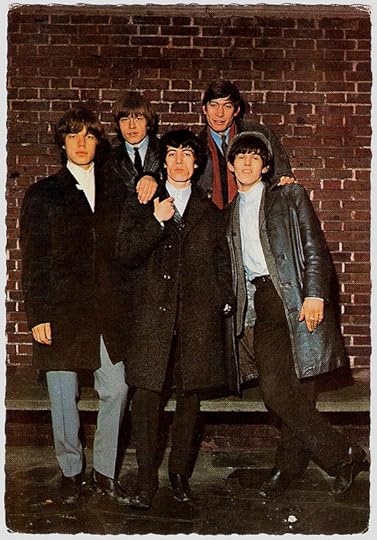
French postcard by PSG / Korès, no. 445.
The British Invasion
The Rolling Stones was formed in 1962 in London when original leader Brian Jones and pianist Ian Stewart were joined by vocalist Mick Jagger and guitarist Keith Richards, whose song writing partnership later contributed to their taking the leadership role in the group.
Bassist Bill Wyman and drummer Charlie Watts completed the early line-up. Ian Stewart was removed from the official line-up in 1963 but continued to work with the band as road manager and keyboardist until his death in 1985.
The band's early recordings were mainly covers of American blues and R&B songs. After first achieving success in the UK, they became popular in the US during the ‘British Invasion’ of the early 1960's.
Their 1965 single (I Can't Get No) Satisfaction established The Rolling Stones as a premier rock and roll act. It was composed by Keith Richards in his sleep, and with the addition of provocative lyrics by Mick Jagger it became their greatest hit.
During 1966-1969 they toured the world, and constantly updated their song-list with many great hits like Lets Spend the night together (1967), Sympathy for the Devil (1968) and Honky Tonk Woman (1969).
The rehearsal and recording of Sympathy for the Devil was filmed by Jean Luc Godard, who used it in his famous satirical collage of rock documentary and political commentary, One Plus One/ Sympathy for the Devil (Jean-Luc Godard, 1968).
The following year the first concert film of the Stones was released: The Stones in the Park (Leslie Woodhead, 1969).
It was followed by the harrowing documentary Gimme Shelter (Albert & David Maysles, 1970). In December of 1969, four months after Woodstock, the Rolling Stones and Jefferson Airplane gave a free concert in Northern California, east of Oakland at Altamont Speedway. About 300,000 people came, and the organizers put Hell's Angels in charge of security around the stage. Armed with pool cues and knifes, Angels spent the concert beating up spectators, killing at least one.
Cocksucker Blues (1972) was a film by photographer Robert Frank on the 1972 American tour. The films was not released by the Stones reportedly because it contained scenes of drug use and groupie orgies.
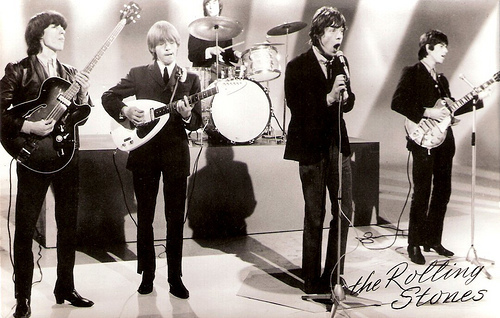
Dutch postcard by 't Sticht, Utrecht, no. AX 6302.
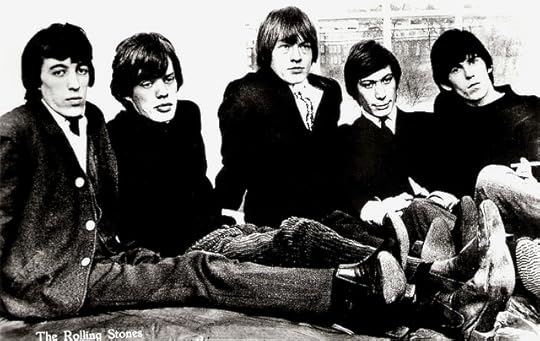
Dutch postcard by 't Sticht, Utrecht, no. AX 1187.
It's Only Rock and Roll
Brian Jones had died in 1969 shortly after being fired from the band and was replaced by Mick Taylor.
But at the end of the 1960’s the creativity of The Rolling Stones reached new highs. Their albums Beggars Banquet (1968) and Sticky Fingers (1971) were among the most popular albums they ever made, having such hits as Wild Horses and Brown Sugar.
During the 1970’s The Rolling Stones remained the biggest band in the world. In 1974 former Faces guitarist Ronnie Wood replaced Mick Taylor, and has been with the band ever since.
The Stones made thousands of live performances and multi-million record sales with hits like Angie (1973), It's Only Rock and Roll (1974), Hot Stuff (1976) and Respectable (1978).
At that time both Keith Richards and Mick Jagger had individual ambitions, and applied their untamed creativity in various projects outside the Stones.
Wyman left the Rolling Stones in 1993; bassist Darryl Jones, who is not an official band member, has worked with the group since 1994.
The Rolling Stones have sold more than 200 million albums worldwide.
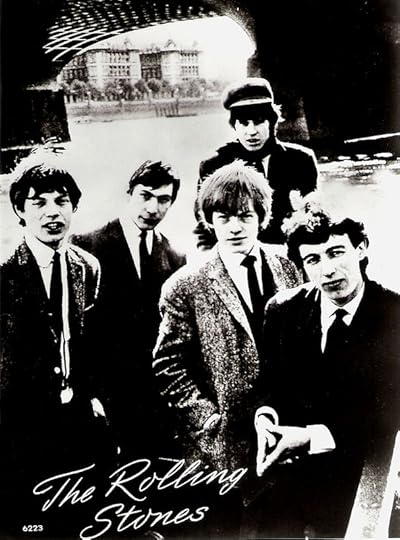
Dutch postcard, no. 6223.
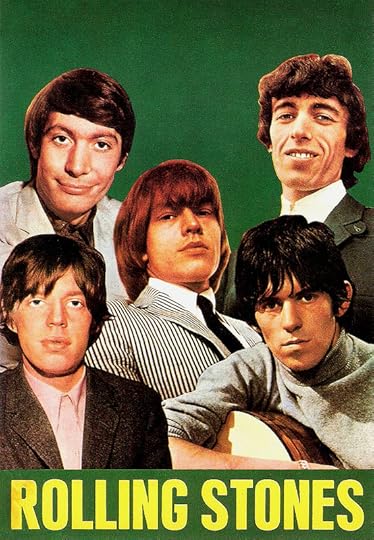
Italian postcard by Silvercart, Milano, no. 516/7.
Challenge to Respectable Standards
Reportedly, Mick Jagger (1943) is the heart of The Stones and Keith Richards (1943) the soul.
Mick Jagger dropped out of college and his every move on-stage and off-stage seemed to signal a challenge to respectable standards. He never received a formal musical education, and even could not read music.
However, he worked hard and emerged as the lead singer and songwriter in partnership with Richards, following the example of John Lennon and Paul McCartney 's song writing for The Beatles .
Mick Jagger starred in several films, such as Performance (Nicolas Roeg, Donald Cammell, 1970), Ned Kelly (Tony Richardson, 1970), Running Out of Luck (Julien Temple, 1987), Freejack (Geoff Murphy, 1992), Bent (Sean Mathias, 1997), and The Man from Elysian Fields (George Hickenlooper, 2001).
Keith Richards, was a schoolmate of Jagger since the primary school. In 1960 they contemplated starting up a band together. Since the formation of the Rolling Stones in 1962, Richards has been the principal songwriting partner with Jagger, and most of the songs on all Rolling Stones albums are credited to Jagger/Richards.
Besides his music career, Richards made a cameo appearance as Captain Teague, the father of Jack Sparrow (Johnny Depp) in Pirates of the Caribbean: At World's End (Gore Verbinski, 2007).
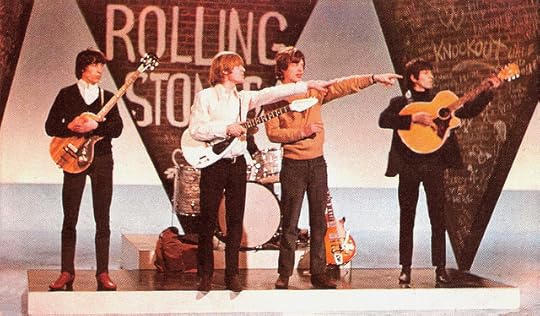
French postcard by PSG, no. 1189. offered by Corvisart, Epinal. Photo: Decca.

Dutch postcard.
50 & Counting
In 2008 the Rolling Stones united with legendary director Martin Scorsese for Shine A Light (2008). For this career-spanning documentary, Scorsese used concert footage from their A Bigger Bang tour and he filmed the Stones over a two-day period at the intimate Beacon Theatre in New York City in fall 2006. In between there are some short clips of old Stones interviews and some Behind-the-Scenes-Footage.
It was followed by The Stones in Exile (Stephen Kijak, 2010). This documentary gives a look at the creation and impact of the 1972 Rolling Stones album Exile on Main St.
The Rolling Stones celebrated their 50th anniversary in the summer of 2012 by releasing a large hardback book titled 50.
It was followed by a documentary titled Crossfire Hurricane (Brett Morgen, 2012). Approximately fifty hours of interviews were conducted by Morgen for use for the documentary, including interviews with Bill Wyman and Mick Taylor.
In November 2012, the Stones started their 50 & Counting tour, which kept them busy throughout 2013, and was followed by the live DVD, Sweet Summer Sun: Live in Hyde Park (2013).
Trailer for Sympathy For The Devil (1968). Source: TriCyclistus (YouTube).
Trailer for Gimme Shelter (1970). Source: Matt Gamble (YouTube).
Trailer for Performance (1970). Source: Performance 786 (YouTube).
Trailer for Bent (1997). Source: ciwciwdotcom (YouTube).
Trailer for the documentary Shine A Light (2008), directed by Martin Scorsese. Source: paramountmovies (YouTube).
Trailer for The Stones in Exile (2010). Source: EagleRockTV (YouTube).
Sources: (IMDb), Wikipedia, and .

French postcard by PSG / Korès, no. 445.
The British Invasion
The Rolling Stones was formed in 1962 in London when original leader Brian Jones and pianist Ian Stewart were joined by vocalist Mick Jagger and guitarist Keith Richards, whose song writing partnership later contributed to their taking the leadership role in the group.
Bassist Bill Wyman and drummer Charlie Watts completed the early line-up. Ian Stewart was removed from the official line-up in 1963 but continued to work with the band as road manager and keyboardist until his death in 1985.
The band's early recordings were mainly covers of American blues and R&B songs. After first achieving success in the UK, they became popular in the US during the ‘British Invasion’ of the early 1960's.
Their 1965 single (I Can't Get No) Satisfaction established The Rolling Stones as a premier rock and roll act. It was composed by Keith Richards in his sleep, and with the addition of provocative lyrics by Mick Jagger it became their greatest hit.
During 1966-1969 they toured the world, and constantly updated their song-list with many great hits like Lets Spend the night together (1967), Sympathy for the Devil (1968) and Honky Tonk Woman (1969).
The rehearsal and recording of Sympathy for the Devil was filmed by Jean Luc Godard, who used it in his famous satirical collage of rock documentary and political commentary, One Plus One/ Sympathy for the Devil (Jean-Luc Godard, 1968).
The following year the first concert film of the Stones was released: The Stones in the Park (Leslie Woodhead, 1969).
It was followed by the harrowing documentary Gimme Shelter (Albert & David Maysles, 1970). In December of 1969, four months after Woodstock, the Rolling Stones and Jefferson Airplane gave a free concert in Northern California, east of Oakland at Altamont Speedway. About 300,000 people came, and the organizers put Hell's Angels in charge of security around the stage. Armed with pool cues and knifes, Angels spent the concert beating up spectators, killing at least one.
Cocksucker Blues (1972) was a film by photographer Robert Frank on the 1972 American tour. The films was not released by the Stones reportedly because it contained scenes of drug use and groupie orgies.

Dutch postcard by 't Sticht, Utrecht, no. AX 6302.

Dutch postcard by 't Sticht, Utrecht, no. AX 1187.
It's Only Rock and Roll
Brian Jones had died in 1969 shortly after being fired from the band and was replaced by Mick Taylor.
But at the end of the 1960’s the creativity of The Rolling Stones reached new highs. Their albums Beggars Banquet (1968) and Sticky Fingers (1971) were among the most popular albums they ever made, having such hits as Wild Horses and Brown Sugar.
During the 1970’s The Rolling Stones remained the biggest band in the world. In 1974 former Faces guitarist Ronnie Wood replaced Mick Taylor, and has been with the band ever since.
The Stones made thousands of live performances and multi-million record sales with hits like Angie (1973), It's Only Rock and Roll (1974), Hot Stuff (1976) and Respectable (1978).
At that time both Keith Richards and Mick Jagger had individual ambitions, and applied their untamed creativity in various projects outside the Stones.
Wyman left the Rolling Stones in 1993; bassist Darryl Jones, who is not an official band member, has worked with the group since 1994.
The Rolling Stones have sold more than 200 million albums worldwide.

Dutch postcard, no. 6223.

Italian postcard by Silvercart, Milano, no. 516/7.
Challenge to Respectable Standards
Reportedly, Mick Jagger (1943) is the heart of The Stones and Keith Richards (1943) the soul.
Mick Jagger dropped out of college and his every move on-stage and off-stage seemed to signal a challenge to respectable standards. He never received a formal musical education, and even could not read music.
However, he worked hard and emerged as the lead singer and songwriter in partnership with Richards, following the example of John Lennon and Paul McCartney 's song writing for The Beatles .
Mick Jagger starred in several films, such as Performance (Nicolas Roeg, Donald Cammell, 1970), Ned Kelly (Tony Richardson, 1970), Running Out of Luck (Julien Temple, 1987), Freejack (Geoff Murphy, 1992), Bent (Sean Mathias, 1997), and The Man from Elysian Fields (George Hickenlooper, 2001).
Keith Richards, was a schoolmate of Jagger since the primary school. In 1960 they contemplated starting up a band together. Since the formation of the Rolling Stones in 1962, Richards has been the principal songwriting partner with Jagger, and most of the songs on all Rolling Stones albums are credited to Jagger/Richards.
Besides his music career, Richards made a cameo appearance as Captain Teague, the father of Jack Sparrow (Johnny Depp) in Pirates of the Caribbean: At World's End (Gore Verbinski, 2007).

French postcard by PSG, no. 1189. offered by Corvisart, Epinal. Photo: Decca.

Dutch postcard.
50 & Counting
In 2008 the Rolling Stones united with legendary director Martin Scorsese for Shine A Light (2008). For this career-spanning documentary, Scorsese used concert footage from their A Bigger Bang tour and he filmed the Stones over a two-day period at the intimate Beacon Theatre in New York City in fall 2006. In between there are some short clips of old Stones interviews and some Behind-the-Scenes-Footage.
It was followed by The Stones in Exile (Stephen Kijak, 2010). This documentary gives a look at the creation and impact of the 1972 Rolling Stones album Exile on Main St.
The Rolling Stones celebrated their 50th anniversary in the summer of 2012 by releasing a large hardback book titled 50.
It was followed by a documentary titled Crossfire Hurricane (Brett Morgen, 2012). Approximately fifty hours of interviews were conducted by Morgen for use for the documentary, including interviews with Bill Wyman and Mick Taylor.
In November 2012, the Stones started their 50 & Counting tour, which kept them busy throughout 2013, and was followed by the live DVD, Sweet Summer Sun: Live in Hyde Park (2013).
Trailer for Sympathy For The Devil (1968). Source: TriCyclistus (YouTube).
Trailer for Gimme Shelter (1970). Source: Matt Gamble (YouTube).
Trailer for Performance (1970). Source: Performance 786 (YouTube).
Trailer for Bent (1997). Source: ciwciwdotcom (YouTube).
Trailer for the documentary Shine A Light (2008), directed by Martin Scorsese. Source: paramountmovies (YouTube).
Trailer for The Stones in Exile (2010). Source: EagleRockTV (YouTube).
Sources: (IMDb), Wikipedia, and .
Published on March 04, 2014 23:00
March 3, 2014
Carlo Wieth
Danish actor Carlo Wieth (1885-1943) made his film debut in Ekspeditricen/Salesgirl (August Blom, 1911), in which his wife Clara Wieth plays a salesgirl selling gloves. The scene in which she puts him on tightfitting 'glacé' gloves is considered as one of the first examples of eroticism in the Danish cinema.
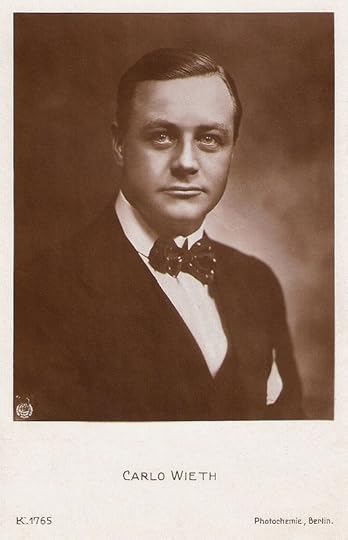
German postcard by Photochemie, Berlin, no. 1765. Photo: Nordisk.
Sjöström, Stiller and Dreyer
Carlo Rossini Wieth was born in Copenhagen, Denmark, in 1885. He was the son of deputy judge Marius Hans Lindegaard Andersen and his wife Jacobine Kirstine Wieth.
Carlo started out as theatre actor and was active at the Danish Royal Theater for over 20 years. From 1906 to 1917 he was married to Clara Pontoppidan, then Clara Wieth . They divorced in 1917, after which Wieth married Agnes Thorberg.
After his start at Kinografen with Ekspeditricen/Salesgirl (August Blom, 1911), he played in some 18 films for Nordisk Film. With his somewhat boyish appearance and his fresh but gentle acting style, he soon became a popular actor.
Between 1913 and 1915 he made nine films in Sweden. There he worked with the famous director Viktor Sjöström on the films Miraklet/The Miracle (1913), Prästen/Saints and Sorrows (1914), Hjärtan som mötas/Hearts That Meet (1914), and Sonad skuld/Guilt Redeemed (1915) with Lili Beck .
He also worked with the other great Swedish film director, Mauritz Stiller on Pa livets ödesvägar/On the Fateful Roads of Life (1913), Det röda tornet/The Red Tower (1914) and Bröderna/Brothers (1914) starring Gunnar Tolnæs . In 1917 Wieth's film career came to a temporary halt.
After a three year intermission, Wieth returned to film with the leading role of Captain Filip Vanderdecken in the Danish serial Den flyvende Hollaender/The Flying Dutchmen (Emanuel Gregers, 1920), and a role in Blade af Satans bog/Leaves Out of the Book of Satan (Carl Theodor Dreyer, 1921) opposite his ex-wife Clara Pontoppidan and newcomer Karina Bell .
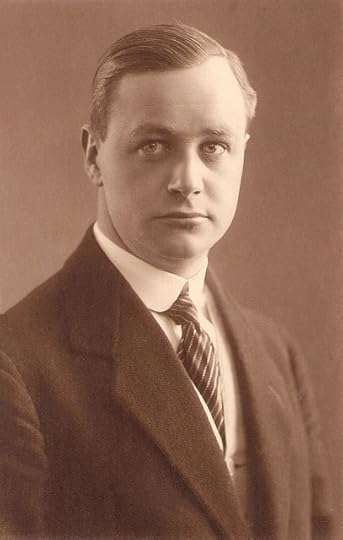
Danish postcard.
Return
For years, Carlo Wieth quitted film again, only returning long after sound had set in. His first sound film was the melodrama Det gyldne smil/The Golden Smile (1935), based on the novel by Kaj Munk and directed by the prolific Hungarian director Pal (Paul) Fejös. After a career in Hungary, Austria and Hollywood, Fejös had settled down at Nordisk in Denmark.
By now Wieth's film parts were small, and his acting style was theatrical and a bit stiff. Wieth did three films in 1939 including Skilsmissens børn/Children of Divorce (Benjamin Christensen, 1939), and three more in 1942.
His last role was a leading part in Vi kunde ha' det saa rart/We could have it so good (1942), directed by Christen Jul and Mogens Skot-Hansen. In this Palladium comedy, Wieth is a doctor with three lively children in need of a nanny. The doctor has an affair with another woman, but in the end he realizes nanny Lena is the girl (the story reminds of the Sound of Music).
Carlo Wieth died in 1943. He and Agnes Thorberg-Wieth had a son, actor Mogens Wieth.

Lili Beck . Swedish postcard by Svenska Biografteatern. Photo: Ferd Flodin, Stockholm.
Sources: Danske Film Database, Det Danske Film Institute and .

German postcard by Photochemie, Berlin, no. 1765. Photo: Nordisk.
Sjöström, Stiller and Dreyer
Carlo Rossini Wieth was born in Copenhagen, Denmark, in 1885. He was the son of deputy judge Marius Hans Lindegaard Andersen and his wife Jacobine Kirstine Wieth.
Carlo started out as theatre actor and was active at the Danish Royal Theater for over 20 years. From 1906 to 1917 he was married to Clara Pontoppidan, then Clara Wieth . They divorced in 1917, after which Wieth married Agnes Thorberg.
After his start at Kinografen with Ekspeditricen/Salesgirl (August Blom, 1911), he played in some 18 films for Nordisk Film. With his somewhat boyish appearance and his fresh but gentle acting style, he soon became a popular actor.
Between 1913 and 1915 he made nine films in Sweden. There he worked with the famous director Viktor Sjöström on the films Miraklet/The Miracle (1913), Prästen/Saints and Sorrows (1914), Hjärtan som mötas/Hearts That Meet (1914), and Sonad skuld/Guilt Redeemed (1915) with Lili Beck .
He also worked with the other great Swedish film director, Mauritz Stiller on Pa livets ödesvägar/On the Fateful Roads of Life (1913), Det röda tornet/The Red Tower (1914) and Bröderna/Brothers (1914) starring Gunnar Tolnæs . In 1917 Wieth's film career came to a temporary halt.
After a three year intermission, Wieth returned to film with the leading role of Captain Filip Vanderdecken in the Danish serial Den flyvende Hollaender/The Flying Dutchmen (Emanuel Gregers, 1920), and a role in Blade af Satans bog/Leaves Out of the Book of Satan (Carl Theodor Dreyer, 1921) opposite his ex-wife Clara Pontoppidan and newcomer Karina Bell .

Danish postcard.
Return
For years, Carlo Wieth quitted film again, only returning long after sound had set in. His first sound film was the melodrama Det gyldne smil/The Golden Smile (1935), based on the novel by Kaj Munk and directed by the prolific Hungarian director Pal (Paul) Fejös. After a career in Hungary, Austria and Hollywood, Fejös had settled down at Nordisk in Denmark.
By now Wieth's film parts were small, and his acting style was theatrical and a bit stiff. Wieth did three films in 1939 including Skilsmissens børn/Children of Divorce (Benjamin Christensen, 1939), and three more in 1942.
His last role was a leading part in Vi kunde ha' det saa rart/We could have it so good (1942), directed by Christen Jul and Mogens Skot-Hansen. In this Palladium comedy, Wieth is a doctor with three lively children in need of a nanny. The doctor has an affair with another woman, but in the end he realizes nanny Lena is the girl (the story reminds of the Sound of Music).
Carlo Wieth died in 1943. He and Agnes Thorberg-Wieth had a son, actor Mogens Wieth.

Lili Beck . Swedish postcard by Svenska Biografteatern. Photo: Ferd Flodin, Stockholm.
Sources: Danske Film Database, Det Danske Film Institute and .
Published on March 03, 2014 23:00
March 2, 2014
Ilona Massey
Statuesque blonde Ilona Massey (1910-1974) was a Hungarian opera singer who appeared in some Austrian films before she was discovered by Hollywood mogul Louis B. Mayer. MGM billed her as ‘the new Dietrich’ and showcased her in operettas with popular baritone Nelson Eddy. But somehow her Hollywood career never really took off.
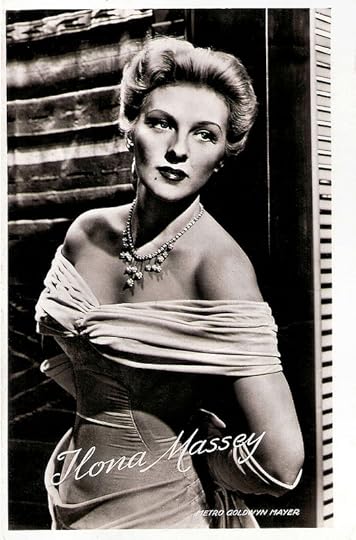
Dutch postcard, no. AX 176. Photo: Metro-Goldwyn-Mayer / Fotoarchief Film en Toneel.
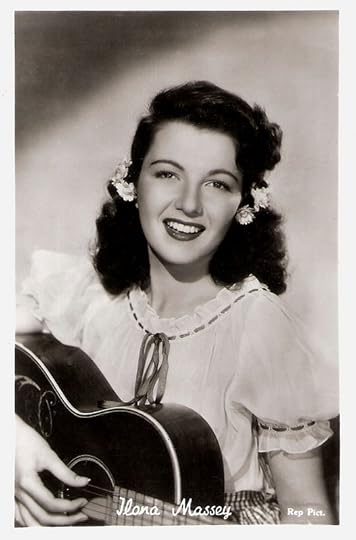
Dutch postcard. Photo: Republic Pictures.
She looks like Dietrich, talks like Garbo
Ilona Massey was born as Ilona Hajmássy in Budapest, Austro-Hungarian Empire (now Hungary) in 1910. Her family was poor. Her father was a typesetter who was left an invalid in World War I. Her father inculcated in her a hatred for communism, which she would carry for her entire life.
As a child she went to work as a dressmaker's apprentice and managed to scrape up money together for singing lessons. She first danced in chorus lines, later earning roles at the Staatsoper Wien (State Opera in Vienna).
According to Wikipedia , Massey was discovered by Hollywood mogul Louis B. Mayer of MGM when she sang Aida in Czechoslovakia. Mayer was enchanted by her offstage voice singing the high priestess's aria. After sending an invitation backstage to join him for supper, Mayer was delighted to see that Ilona Hajmássy was a statuesque blonde with movie-star looks, who could sing and dance.
A Hollywood fabrication? According to IMDb , Massey “submitted her photograph to the Vienna office of MGM and ended up one of 36 European hopefuls to try out Hollywood. Only two succeeded. Ms. Massey and Hedy Lamarr .”
In fact, she had already starred in the Austrian films Der Himmel auf Erden/Heaven on Earth (E.W. Emo, 1935) starring Heinz Rühmann , and Zirkus Saran/Circus Saran (E.W. Emo, 1935) with Leo Slezak and Hans Moser .
In Hollywood, MGM billed her as ‘the new Dietrich’, and gave her a supporting part in the musical Rosalie (W.S. Van Dyke, 1937) starring Nelson Eddy and Eleanor Powell. She played the supporting role of a lady-in-waiting to Powell. Unable to speak English at the time, she spoke her lines phonetically.
Soon she learned to speak the language fluently. Massey played her first starring role opposite Nelson Eddy in Balalaika ( Reinhold Schünzel , 1939), based on the 1936 London stage musical of the same name, which had in turn been inspired by a German operetta.
Roger Fristoe at TCM : “Before Massey was substituted as leading lady, Balalaika had been planned as a vehicle for Eddy and his long-time co-star Jeanette MacDonald.” The film follows the romance of Prince Peter Karagin (Nelson Eddy), captain of the Czar's Cossack Guards, and Lydia Pavlovna Marakova (Ilona Massey), cabaret-cum-opera singer and secret revolutionary, who fall in love on the eve of World War I, are separated by war and ideology, and meet again in 1920s Paris.
Only the musical's title song At the Balalaika, with altered lyrics, was used in the film. Instead, MGM had music director Herbert Stothart adapt materials it already owned or were otherwise available, or write original material as needed.
Previewed in December 1938, most American critics agreed: the stars and production were excellent even if the script and plot were not. Frank S. Nugent's review in The New York Times praised Massey's blond good looks and Eddy's competence: "She looks like Dietrich, talks like Garbo... while leaving the bulk of (the score) safely to Mr. Eddy..."
Critics went on to prophesy a glowing career for Massey but somehow that career would never really take off. Roger Fristoe: “Despite the promise of Balalaika, Massey's career turned out to be a disappointing one that played out in minor film and TV appearances.”
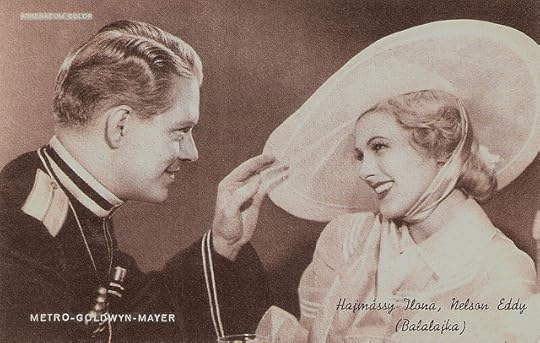
Hungarian postcard. Photo: Metro-Goldwyn-Mayer. Publicity still for Balalaika (1939).
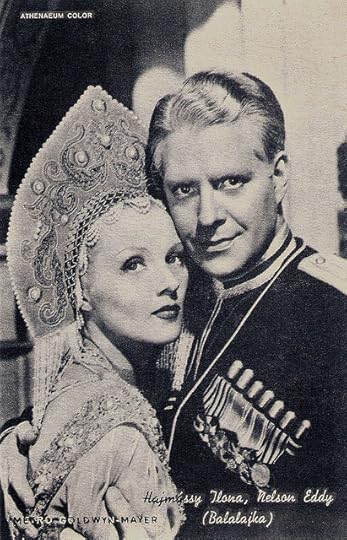
Hungarian postcard by Athenaeum Color. Photo: Metro-Goldwyn-Mayer. Publicity still for Balalaika (1939).
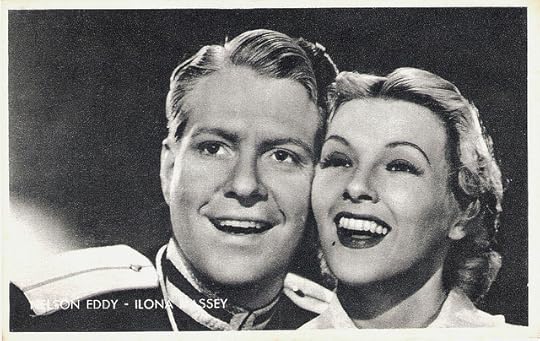
Belgian collector's card by Kwatta, no. C. 182. Photo: Metro-Goldwyn-Mayer. Publicity still for Balalaika (1939).
A Staunch Conservative Republican
Ilona Massey co-starred with Alan Curtis in the historical film The Great Awakening/New Wine (1941), a biography of composer Franz Schubert produced by Gloria Pictures Corporation, and released by United Artists. Star Alan Curtis would become her second husband. Like Balalaika, the film was directed by Reinhold Schünzel , who was an exile from Nazi Germany and whose last direction this was.
Massey appeared as a beautiful singer in the wartime spy-drama International Lady (Tim Whelan, 1941) starring George Brent, and she played Baroness Frankenstein in Frankenstein Meets the Wolf Man (Roy William Neill, 1943) with Lon Chaney Jr. and Bela Lugosi.
Gary Brumburgh at IMDb gives an indication why her Hollywood career went nowhere: “Massey did not live up to the hype as her soprano voice was deemed too light for the screen and her acting talent too slight and mannered.”
In 1943, she appeared on Broadway in the Ziegfeld Follies of 1943. The musical was a huge success and ran for more than 500 performances. Becoming an American citizen in 1946, she remained strongly anti-communist for what she saw as the destruction of her native country.
In 1947, she co-starred for a third time with Nelson Eddy in the musical Western Northwest Outpost (Allan Dwan, 1947), composed by Rudolf Friml. Northwest Outpost was Eddy’s final film, and was produced by Republic Pictures. It was well received by critics and had a strong box office performance.
Next she starred in Love Happy (David Miller, 1949), the fourteenth and worst feature starring the Marx Brothers. She played Madame Egelichi, a femme fatale spy who is after Harpo, and her performance inspired Milton Caniff in the creation of his femme fatale spy, Madame Lynx, in the comic strip Steve Canyon . Caniff hired Massey to pose for him.
On TV, she starred in the adventure weekly Rendezvous (1952). From the end of 1954 on, she hosted DuMont's The Ilona Massey Show, a weekly musical variety show in which she sang songs with guests in a nightclub set, with music provided by the Irving Fields Trio. The series ended after only 10 episodes.
Massey was a staunch conservative Republican. In 1954 a special subcommittee of the House of Representatives held hearings in Manhattan on communist aggression in Eastern Europe and Massey became their star witness, testifying to the rape, murder and robbery committed by Soviet agents against her Hungarian native land. After the 1956 Hungarian uprising, she picketed in protest when Soviet Premier Nikita Khrushchev and Deputy Premier Anastas Mikoyan visited the US.
In 1959 she returned one more time to the cinema in the B-film Jet Over the Atlantic (Byron Haskin, 1959) starring Guy Madison. Then she retired and spent her time as a respected Washington socialite. Her film career had been brief: she appeared in only 2 Austrian and 11 American films.
In 1974, Ilona Massey died of cancer in Bethesda, Maryland at the age of 64. She is buried in Virginia's Arlington National Cemetery near her fourth husband since 1955, Donald Dawson, who had served in the United States Air Force Reserve as a Major General. She had also been married to Nick Szavazd (1935-1936), actor Alan Curtis (1941-1942) and jewellery shop owner Charles Walker (1952-1954), all three marriages had ended in a divorce.
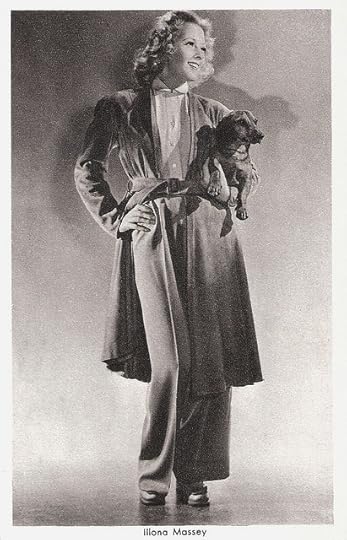
Dutch postcard.
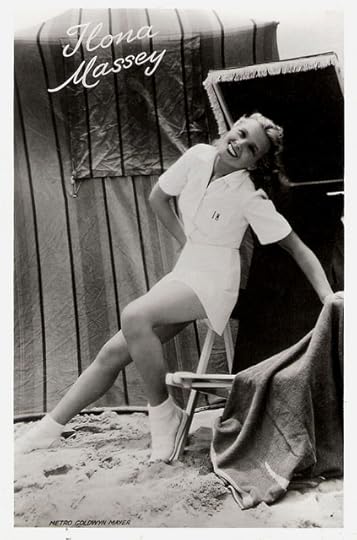
Dutch postcard. Photo: Metro-Goldwyn-Mayer.
British postcard in the Picturegoer Series, London, no. 1294a. Photo: Metro-Goldwyn-Mayer.
Sources: Roger Fristoe (TCM), Hal Erickson (AllMovie), Find A Grave, Wikipedia, and .

Dutch postcard, no. AX 176. Photo: Metro-Goldwyn-Mayer / Fotoarchief Film en Toneel.

Dutch postcard. Photo: Republic Pictures.
She looks like Dietrich, talks like Garbo
Ilona Massey was born as Ilona Hajmássy in Budapest, Austro-Hungarian Empire (now Hungary) in 1910. Her family was poor. Her father was a typesetter who was left an invalid in World War I. Her father inculcated in her a hatred for communism, which she would carry for her entire life.
As a child she went to work as a dressmaker's apprentice and managed to scrape up money together for singing lessons. She first danced in chorus lines, later earning roles at the Staatsoper Wien (State Opera in Vienna).
According to Wikipedia , Massey was discovered by Hollywood mogul Louis B. Mayer of MGM when she sang Aida in Czechoslovakia. Mayer was enchanted by her offstage voice singing the high priestess's aria. After sending an invitation backstage to join him for supper, Mayer was delighted to see that Ilona Hajmássy was a statuesque blonde with movie-star looks, who could sing and dance.
A Hollywood fabrication? According to IMDb , Massey “submitted her photograph to the Vienna office of MGM and ended up one of 36 European hopefuls to try out Hollywood. Only two succeeded. Ms. Massey and Hedy Lamarr .”
In fact, she had already starred in the Austrian films Der Himmel auf Erden/Heaven on Earth (E.W. Emo, 1935) starring Heinz Rühmann , and Zirkus Saran/Circus Saran (E.W. Emo, 1935) with Leo Slezak and Hans Moser .
In Hollywood, MGM billed her as ‘the new Dietrich’, and gave her a supporting part in the musical Rosalie (W.S. Van Dyke, 1937) starring Nelson Eddy and Eleanor Powell. She played the supporting role of a lady-in-waiting to Powell. Unable to speak English at the time, she spoke her lines phonetically.
Soon she learned to speak the language fluently. Massey played her first starring role opposite Nelson Eddy in Balalaika ( Reinhold Schünzel , 1939), based on the 1936 London stage musical of the same name, which had in turn been inspired by a German operetta.
Roger Fristoe at TCM : “Before Massey was substituted as leading lady, Balalaika had been planned as a vehicle for Eddy and his long-time co-star Jeanette MacDonald.” The film follows the romance of Prince Peter Karagin (Nelson Eddy), captain of the Czar's Cossack Guards, and Lydia Pavlovna Marakova (Ilona Massey), cabaret-cum-opera singer and secret revolutionary, who fall in love on the eve of World War I, are separated by war and ideology, and meet again in 1920s Paris.
Only the musical's title song At the Balalaika, with altered lyrics, was used in the film. Instead, MGM had music director Herbert Stothart adapt materials it already owned or were otherwise available, or write original material as needed.
Previewed in December 1938, most American critics agreed: the stars and production were excellent even if the script and plot were not. Frank S. Nugent's review in The New York Times praised Massey's blond good looks and Eddy's competence: "She looks like Dietrich, talks like Garbo... while leaving the bulk of (the score) safely to Mr. Eddy..."
Critics went on to prophesy a glowing career for Massey but somehow that career would never really take off. Roger Fristoe: “Despite the promise of Balalaika, Massey's career turned out to be a disappointing one that played out in minor film and TV appearances.”

Hungarian postcard. Photo: Metro-Goldwyn-Mayer. Publicity still for Balalaika (1939).

Hungarian postcard by Athenaeum Color. Photo: Metro-Goldwyn-Mayer. Publicity still for Balalaika (1939).

Belgian collector's card by Kwatta, no. C. 182. Photo: Metro-Goldwyn-Mayer. Publicity still for Balalaika (1939).
A Staunch Conservative Republican
Ilona Massey co-starred with Alan Curtis in the historical film The Great Awakening/New Wine (1941), a biography of composer Franz Schubert produced by Gloria Pictures Corporation, and released by United Artists. Star Alan Curtis would become her second husband. Like Balalaika, the film was directed by Reinhold Schünzel , who was an exile from Nazi Germany and whose last direction this was.
Massey appeared as a beautiful singer in the wartime spy-drama International Lady (Tim Whelan, 1941) starring George Brent, and she played Baroness Frankenstein in Frankenstein Meets the Wolf Man (Roy William Neill, 1943) with Lon Chaney Jr. and Bela Lugosi.
Gary Brumburgh at IMDb gives an indication why her Hollywood career went nowhere: “Massey did not live up to the hype as her soprano voice was deemed too light for the screen and her acting talent too slight and mannered.”
In 1943, she appeared on Broadway in the Ziegfeld Follies of 1943. The musical was a huge success and ran for more than 500 performances. Becoming an American citizen in 1946, she remained strongly anti-communist for what she saw as the destruction of her native country.
In 1947, she co-starred for a third time with Nelson Eddy in the musical Western Northwest Outpost (Allan Dwan, 1947), composed by Rudolf Friml. Northwest Outpost was Eddy’s final film, and was produced by Republic Pictures. It was well received by critics and had a strong box office performance.
Next she starred in Love Happy (David Miller, 1949), the fourteenth and worst feature starring the Marx Brothers. She played Madame Egelichi, a femme fatale spy who is after Harpo, and her performance inspired Milton Caniff in the creation of his femme fatale spy, Madame Lynx, in the comic strip Steve Canyon . Caniff hired Massey to pose for him.
On TV, she starred in the adventure weekly Rendezvous (1952). From the end of 1954 on, she hosted DuMont's The Ilona Massey Show, a weekly musical variety show in which she sang songs with guests in a nightclub set, with music provided by the Irving Fields Trio. The series ended after only 10 episodes.
Massey was a staunch conservative Republican. In 1954 a special subcommittee of the House of Representatives held hearings in Manhattan on communist aggression in Eastern Europe and Massey became their star witness, testifying to the rape, murder and robbery committed by Soviet agents against her Hungarian native land. After the 1956 Hungarian uprising, she picketed in protest when Soviet Premier Nikita Khrushchev and Deputy Premier Anastas Mikoyan visited the US.
In 1959 she returned one more time to the cinema in the B-film Jet Over the Atlantic (Byron Haskin, 1959) starring Guy Madison. Then she retired and spent her time as a respected Washington socialite. Her film career had been brief: she appeared in only 2 Austrian and 11 American films.
In 1974, Ilona Massey died of cancer in Bethesda, Maryland at the age of 64. She is buried in Virginia's Arlington National Cemetery near her fourth husband since 1955, Donald Dawson, who had served in the United States Air Force Reserve as a Major General. She had also been married to Nick Szavazd (1935-1936), actor Alan Curtis (1941-1942) and jewellery shop owner Charles Walker (1952-1954), all three marriages had ended in a divorce.

Dutch postcard.

Dutch postcard. Photo: Metro-Goldwyn-Mayer.
British postcard in the Picturegoer Series, London, no. 1294a. Photo: Metro-Goldwyn-Mayer.
Sources: Roger Fristoe (TCM), Hal Erickson (AllMovie), Find A Grave, Wikipedia, and .
Published on March 02, 2014 23:00
March 1, 2014
Franca Bettoia
Italian actress Franca Bettoia (1936) starred in several Italian films of the 1950s and 1960s. She is best known for the chilling sci-fi/horror tale The Last Man on Earth (1964).

Italian postcard by Rotalcolour, no. 79.
Mao Tse Tung
Franca Bettoia (sometimes written as Bettoja) was born in 1936 in Rome, Italy.
Her first film appearance was in Un Palco all'opera (Siro Marcellini, 1955). The following year she played a supporting part in the Spanish-Italian production Los amantes del desierto/Desert Warrior (Goffredo Alessandrini a.o., 1956), but the lush desert epic wasn't released until two years later. It starred Riccardo Montalban, the beautiful Carmen Sevilla and Gino Cervi .
Next Franca appeared opposite Pietro Germi in L’Uomo di paglia/A Man of Straw (Pietro Germi, 1958), and opposite Macha Méril and Jacques Charrier in the French production La main chaude/The Itchy Palm (Gérard Oury, 1960).
She appeared as a nun in China in Apocalisse sul fiume giallo/The Dam on the Yellow River (Renzo Merusi, 1960), an anti-Communist propaganda film, in which the victory of Mao Tse-Tung's People's Liberation Army is seen through the eyes of an American journalist ( Georges Marchal ) reporting from the Nationalists' side.
The next year she starred opposite Hollywood star Alan Ladd at the end of his career in Orazi e curiazi/Duel of the Champions (Terence Young, Ferdinando Baldi, 1961), a Peplum (a sword and sandals adventure) set in ancient Rome. The screenplay was written by such prestigious writers as Carlo Lizzani, Giuliano Montaldo and Luciano Vincenzoni (Sergio Leone's usual script writer).
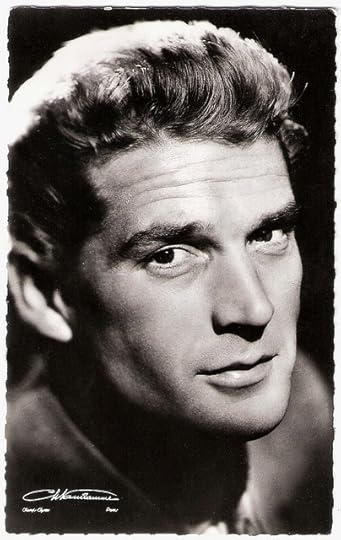
Georges Marchal . French postcard by Editions du Globe, Paris, no. 297. Photo: Charles VanDamme, Paris.
Vampire-like Creatures
In 1964 Franca Bettoia co-starred with Vincent Price in the horror/science fiction film L'Ultimo uomo della Terra/The Last Man on Earth (Ubaldo Ragone, Sidney Salkow, 1964). This is the first screen version of Richard Matheson's novel I Am Legend, later filmed again as The Omega Man (Boris Sagal, 1971) with Charlton Heston, and as I Am Legend (Francis Lawrence, 2007), starring Will Smith.
The script was written in part by Matheson, but he was dissatisfied with the result and was therefore credited as Logan Swanson. William Leicester, Furio M. Monetti, and Ubaldo Ragona were the other writers. In the year 1968, Dr. Robert Morgan (Vincent Price) wakes up to find a world where everyone else has been infected by a disease that turns them into vampire-like creatures. During the day he gathers his weapons and goes out vampire hunting and by night he locks himself inside his house. One day he finds a beautiful woman (Franca Bettoia) who seems disease free and takes her home but he becomes suspicious when he catches her injecting himself with a serum. She then explains that there are others like her trying to rebuild civilization.
Next Franca Bettoia was a princess in distress opposite Ray Danton and Guy Madison in the adventure films Sandokan alla riscossa/Sandokan Fights Back (Luigi Capuano, 1964) and Sandokan contro il leopardo di Sarawak/Sandokan Against the Leopard of Sarawak (Luigi Capuano, 1964).
In 1967 she appeared as Ugo Tognazzi’s lover in the social comedy Il fischio al naso/The Seventh Floor (1967). Tognazzi also produced and directed the film. He plays a successful business man who occasionally develops an unusual physical disturbance: his nose whistles, whenever he breathes. Bettoia and Tognazzi became also lovers in real life and they were married in 1972.
Franca Bettoia would play in only three more films, who were all of interest. In the comedy Riusciranno i nostri eroi a ritrovare l'amico misteriosamente scomparso in Africa?/Will Our Heroes Be Able to Find Their Friend Who Has Mysteriously Disappeared in Africa? (Ettore Scola, 1968) she appeared as the wife of Alberto Sordi, a rich businessman who is fed up with work, family, society, and goes with a friend (Bernard Blier) to Africa, in search of another friend who had vanished there in mysterious circumstances. They find him as a tribal chief, surrounded with topless, shapely wives.
In her next film, Touche pas à la femme blanche/Don’t Touch the White Woman (Marco Ferreri, 1974), the stars were Catherine Deneuve , Marcello Mastroianni and Michel Piccoli. The film tells a page of shame of American history as General George Custer prepared, and later battled, the Indians in the battle of Little Big Horn that was his last stand as a military man. Director Marco ferreri staged his film in a construction site in the centre of Paris. (The site where the Pompidou Center would be erected).
Franca Bettoia's last film, Teste rasate (Claudio Fragasso, 1993) is a drama about skinheads, in which she played the mother of the lead character played by her son, Gianmarco Tognazzi.
Franca Bettoia and Ugo Tognazzi, who died in 1990, have also a daughter, film director Maria Sole Tognazzi.
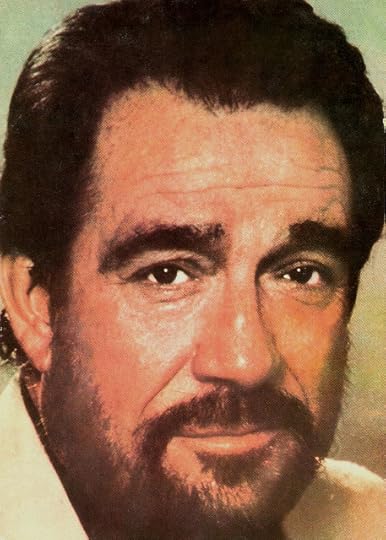
Ugo Tognazzi. Romanian postcard by Casa Filmului Acin.
Sources: Wikipedia and .

Italian postcard by Rotalcolour, no. 79.
Mao Tse Tung
Franca Bettoia (sometimes written as Bettoja) was born in 1936 in Rome, Italy.
Her first film appearance was in Un Palco all'opera (Siro Marcellini, 1955). The following year she played a supporting part in the Spanish-Italian production Los amantes del desierto/Desert Warrior (Goffredo Alessandrini a.o., 1956), but the lush desert epic wasn't released until two years later. It starred Riccardo Montalban, the beautiful Carmen Sevilla and Gino Cervi .
Next Franca appeared opposite Pietro Germi in L’Uomo di paglia/A Man of Straw (Pietro Germi, 1958), and opposite Macha Méril and Jacques Charrier in the French production La main chaude/The Itchy Palm (Gérard Oury, 1960).
She appeared as a nun in China in Apocalisse sul fiume giallo/The Dam on the Yellow River (Renzo Merusi, 1960), an anti-Communist propaganda film, in which the victory of Mao Tse-Tung's People's Liberation Army is seen through the eyes of an American journalist ( Georges Marchal ) reporting from the Nationalists' side.
The next year she starred opposite Hollywood star Alan Ladd at the end of his career in Orazi e curiazi/Duel of the Champions (Terence Young, Ferdinando Baldi, 1961), a Peplum (a sword and sandals adventure) set in ancient Rome. The screenplay was written by such prestigious writers as Carlo Lizzani, Giuliano Montaldo and Luciano Vincenzoni (Sergio Leone's usual script writer).

Georges Marchal . French postcard by Editions du Globe, Paris, no. 297. Photo: Charles VanDamme, Paris.
Vampire-like Creatures
In 1964 Franca Bettoia co-starred with Vincent Price in the horror/science fiction film L'Ultimo uomo della Terra/The Last Man on Earth (Ubaldo Ragone, Sidney Salkow, 1964). This is the first screen version of Richard Matheson's novel I Am Legend, later filmed again as The Omega Man (Boris Sagal, 1971) with Charlton Heston, and as I Am Legend (Francis Lawrence, 2007), starring Will Smith.
The script was written in part by Matheson, but he was dissatisfied with the result and was therefore credited as Logan Swanson. William Leicester, Furio M. Monetti, and Ubaldo Ragona were the other writers. In the year 1968, Dr. Robert Morgan (Vincent Price) wakes up to find a world where everyone else has been infected by a disease that turns them into vampire-like creatures. During the day he gathers his weapons and goes out vampire hunting and by night he locks himself inside his house. One day he finds a beautiful woman (Franca Bettoia) who seems disease free and takes her home but he becomes suspicious when he catches her injecting himself with a serum. She then explains that there are others like her trying to rebuild civilization.
Next Franca Bettoia was a princess in distress opposite Ray Danton and Guy Madison in the adventure films Sandokan alla riscossa/Sandokan Fights Back (Luigi Capuano, 1964) and Sandokan contro il leopardo di Sarawak/Sandokan Against the Leopard of Sarawak (Luigi Capuano, 1964).
In 1967 she appeared as Ugo Tognazzi’s lover in the social comedy Il fischio al naso/The Seventh Floor (1967). Tognazzi also produced and directed the film. He plays a successful business man who occasionally develops an unusual physical disturbance: his nose whistles, whenever he breathes. Bettoia and Tognazzi became also lovers in real life and they were married in 1972.
Franca Bettoia would play in only three more films, who were all of interest. In the comedy Riusciranno i nostri eroi a ritrovare l'amico misteriosamente scomparso in Africa?/Will Our Heroes Be Able to Find Their Friend Who Has Mysteriously Disappeared in Africa? (Ettore Scola, 1968) she appeared as the wife of Alberto Sordi, a rich businessman who is fed up with work, family, society, and goes with a friend (Bernard Blier) to Africa, in search of another friend who had vanished there in mysterious circumstances. They find him as a tribal chief, surrounded with topless, shapely wives.
In her next film, Touche pas à la femme blanche/Don’t Touch the White Woman (Marco Ferreri, 1974), the stars were Catherine Deneuve , Marcello Mastroianni and Michel Piccoli. The film tells a page of shame of American history as General George Custer prepared, and later battled, the Indians in the battle of Little Big Horn that was his last stand as a military man. Director Marco ferreri staged his film in a construction site in the centre of Paris. (The site where the Pompidou Center would be erected).
Franca Bettoia's last film, Teste rasate (Claudio Fragasso, 1993) is a drama about skinheads, in which she played the mother of the lead character played by her son, Gianmarco Tognazzi.
Franca Bettoia and Ugo Tognazzi, who died in 1990, have also a daughter, film director Maria Sole Tognazzi.

Ugo Tognazzi. Romanian postcard by Casa Filmului Acin.
Sources: Wikipedia and .
Published on March 01, 2014 23:00
February 28, 2014
Becker & Maass
Becker & Maass was a German studio for portrait and fashion photography in the first decades of the 20th Century. They portrayed dozens of German film stars for magazines and postcards.
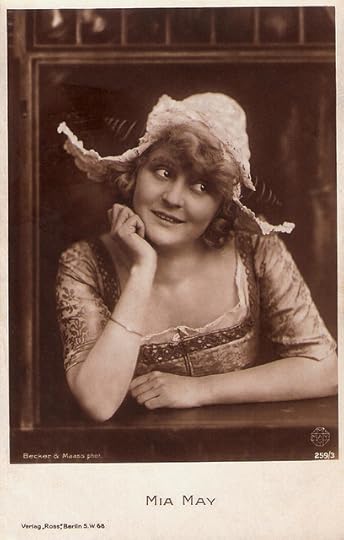
Mia May . German postcard by Ross Verlag, Berlin, no. 259/3, 1919-1921. Sent by mail in Germany in 1921. Photo: Becker & Maass / May Film.
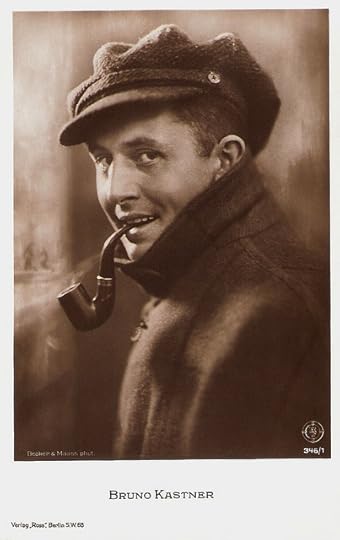
Bruno Kastner . German postcard by Ross Verlag, no. 346/1, 1919-1924. Photo: Becker & Maass / RF.

Asta Nielsen . German postcard by Ross Verlag, no. 470/2, 1919-1924. Photo: Becker & Maass, Berlin.
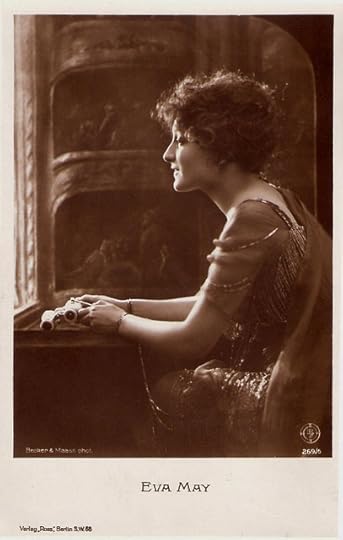
Eva May . German postcard by Ross Verlag, no. 269/1, 1919-1924 (Film Sterne Film Scene Card). Photo: Becker & Maass Phot.
A Series of Holland
Little is known about the Berlin company Becker & Maaß (or Maass), which made so many film star portraits in the late 1910s and early 1920s.
During the late 1870s, Otto Becker had a studio located at Leipziger Strasse 94 in Berlin. Heinrich Maass name appears in conjunction on cartes de visite dated in the 1890s.
They founded Becker & Maaß in Berlin in 1902. The studio made a beautiful picture of Geisha girls in Berlin, and they travelled to Holland for a series of photographs. Pictures of a sailors family from the island Marken, farm houses, boys on wooden clogs and girls in traditional clothes were published in magazines like Praktische Berlinerin in 1907-1910.
They also did landscapes and portraits. Among the celebrities they portrayed were publisher Ernst Rowohlt, author Gerhardt Hauptmann, Russian dancer Anna Pavlova, Dutch playwright Herman Heijermans and stage actor Alexander Moissi .
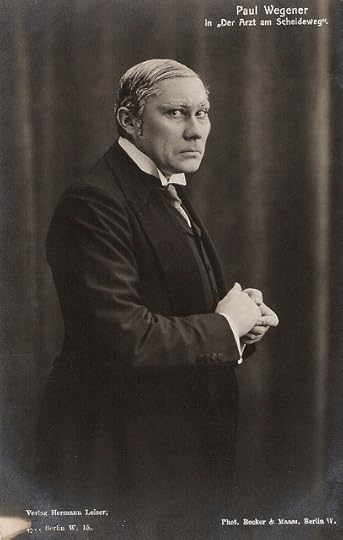
Paul Wegener . German postcard by Verlag Hermann Leiser, Berlin, no. 1233. Photo: Becker & Maass, Berlin. Publicity still for the play Der Arzt am Scheideweg (The Doctor's Dilemma) by George Bernhard Shaw.
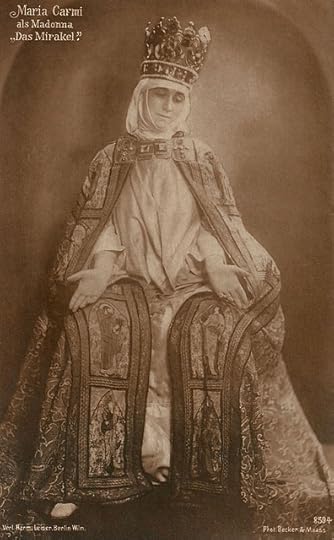
Maria Carmi in Das Mirakel. German postcard by Verleih Hermann Leiser, Berlin-Wilmersdorf, no. 8594. Photo: Becker & Maass.

Bruno Decarli . German postcard by Verlag Hermann Leiser, Berlin, no. 8977. Photo: Becker & Maass, Berlin.

Dagny Servaes . German postcard by Hermann Leiser, Berlin, no. 8245. Photo: Becker & Maass. Publicity still for Der Bogen des Odysseus. Collection: Didier Hanson.

Paul Hartmann . German postcard by Verleih Hermann Leiser, Berlin, no. 8766. Photo: Becker & Maass.
The Modern Film Stars
Between ca. 1917 and 1933, Marie Böhm was the studio photographer.
Becker & Maass then focused on portrait photography while the German film industry started booming after WW I.
The studio photographed many of the new stars of the silent Weimar cinema. Among their customers were the Danish diva Asta Nielsen , her German counterpart Henny Porten , serial queen Mia May , Paul Wegener and women idol Bruno Kastner .
Many modern young ladies, like Mia’s daughter Eva May , Lotte Neumann , Wanda Treumann and Hanni Weisse , were glamorously portrayed by the studio.

Hedda Vernon . German postcard in the Film Sterne series by Rotophot, no. 232/1. Photo: Becker & Maass / Eiko-Film.
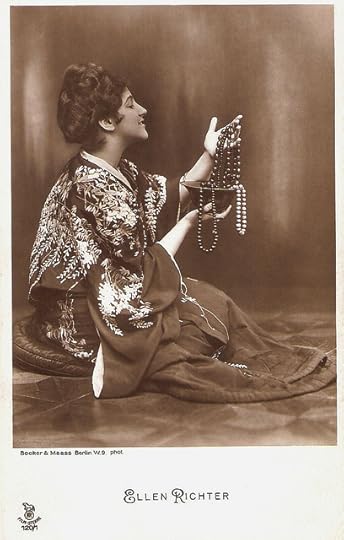
Ellen Richter . German postcard in the Film Sterne Series by Rotophot, no. 120/1. Photo: Becker & Maass, Berlin. Collection: Didier Hanson.
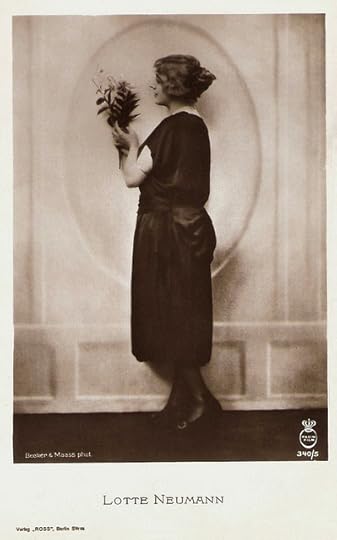
Lotte Neumann . German postcard by Ross Verlag, Berlin, no. 340/5, 1919-1924. Photo: Becker & Maass / Maxim Film.

Evi Eva . German postcard by Ross Verlag, no. 1790/1, 1927-1928. Photo: Becker & Maass, Berlin.

Lee Parry . German postcard by Ross Verlag, no. 3616/1, 1928-1929. Photo: Becker & Maass, Berlin.
With A Mouse In Her Hand
Becker & Maas photographed Controversial dancer-actress Anita Berber was photographed with a mouse in her hand.
These sepia star portraits quickly found their ways to Berlin magazines and countless postcards. Initially these postcards were published by Verlag Hermann Leiser and Rotophot, and later by Ross Verlag.
In 1933 the studio was sold to Else Kutznitzki, who probably worked there till 1938. She maintained the studio’s name during this period an focused on fashion and design photography.
What happened to Otto Becker and Heinrich Maass is not known.

Theodor Loos . German postcard by Verlag Hermann Leiser. Photo: Becker und Maass, Berlin. Kaiser und Galiläer (Emperor and Galilean) was not a film but a play by Henrik Ibsen, in which Loos played the part of Emperor Julian.

Ida Wüst and Bruno Kastner . German postcard by Rotophot, no. 220/1. Photo: Becker & Maass, Berlin.

Anita Berber . German postcard by Rotophot in the Film Sterne series. Photo: Becker & Maass. Collection: Didier Hanson.

Eva May . German postcard by Ross Verlag, Berlin, no. 269/5, 1919-1924. Photo: Becker & Maass.
This is the eighth post in a series on film star photographers. Earlier posts were on the Reutlinger Studio in Paris, Italian star photographer Attilio Badodi, the German photographer Ernst Schneider, Dutch photo artist Godfried de Groot, Milanese photographers Arturo Varischi and Giovanni Artico. the French Studio Lorelle and the British 'royal' photographer Dorothy Wilding.
Sources: John Toohey (Luminous Lint) and Fotografen Wiki (German).

Mia May . German postcard by Ross Verlag, Berlin, no. 259/3, 1919-1921. Sent by mail in Germany in 1921. Photo: Becker & Maass / May Film.

Bruno Kastner . German postcard by Ross Verlag, no. 346/1, 1919-1924. Photo: Becker & Maass / RF.

Asta Nielsen . German postcard by Ross Verlag, no. 470/2, 1919-1924. Photo: Becker & Maass, Berlin.

Eva May . German postcard by Ross Verlag, no. 269/1, 1919-1924 (Film Sterne Film Scene Card). Photo: Becker & Maass Phot.
A Series of Holland
Little is known about the Berlin company Becker & Maaß (or Maass), which made so many film star portraits in the late 1910s and early 1920s.
During the late 1870s, Otto Becker had a studio located at Leipziger Strasse 94 in Berlin. Heinrich Maass name appears in conjunction on cartes de visite dated in the 1890s.
They founded Becker & Maaß in Berlin in 1902. The studio made a beautiful picture of Geisha girls in Berlin, and they travelled to Holland for a series of photographs. Pictures of a sailors family from the island Marken, farm houses, boys on wooden clogs and girls in traditional clothes were published in magazines like Praktische Berlinerin in 1907-1910.
They also did landscapes and portraits. Among the celebrities they portrayed were publisher Ernst Rowohlt, author Gerhardt Hauptmann, Russian dancer Anna Pavlova, Dutch playwright Herman Heijermans and stage actor Alexander Moissi .

Paul Wegener . German postcard by Verlag Hermann Leiser, Berlin, no. 1233. Photo: Becker & Maass, Berlin. Publicity still for the play Der Arzt am Scheideweg (The Doctor's Dilemma) by George Bernhard Shaw.

Maria Carmi in Das Mirakel. German postcard by Verleih Hermann Leiser, Berlin-Wilmersdorf, no. 8594. Photo: Becker & Maass.

Bruno Decarli . German postcard by Verlag Hermann Leiser, Berlin, no. 8977. Photo: Becker & Maass, Berlin.

Dagny Servaes . German postcard by Hermann Leiser, Berlin, no. 8245. Photo: Becker & Maass. Publicity still for Der Bogen des Odysseus. Collection: Didier Hanson.

Paul Hartmann . German postcard by Verleih Hermann Leiser, Berlin, no. 8766. Photo: Becker & Maass.
The Modern Film Stars
Between ca. 1917 and 1933, Marie Böhm was the studio photographer.
Becker & Maass then focused on portrait photography while the German film industry started booming after WW I.
The studio photographed many of the new stars of the silent Weimar cinema. Among their customers were the Danish diva Asta Nielsen , her German counterpart Henny Porten , serial queen Mia May , Paul Wegener and women idol Bruno Kastner .
Many modern young ladies, like Mia’s daughter Eva May , Lotte Neumann , Wanda Treumann and Hanni Weisse , were glamorously portrayed by the studio.

Hedda Vernon . German postcard in the Film Sterne series by Rotophot, no. 232/1. Photo: Becker & Maass / Eiko-Film.

Ellen Richter . German postcard in the Film Sterne Series by Rotophot, no. 120/1. Photo: Becker & Maass, Berlin. Collection: Didier Hanson.

Lotte Neumann . German postcard by Ross Verlag, Berlin, no. 340/5, 1919-1924. Photo: Becker & Maass / Maxim Film.

Evi Eva . German postcard by Ross Verlag, no. 1790/1, 1927-1928. Photo: Becker & Maass, Berlin.

Lee Parry . German postcard by Ross Verlag, no. 3616/1, 1928-1929. Photo: Becker & Maass, Berlin.
With A Mouse In Her Hand
Becker & Maas photographed Controversial dancer-actress Anita Berber was photographed with a mouse in her hand.
These sepia star portraits quickly found their ways to Berlin magazines and countless postcards. Initially these postcards were published by Verlag Hermann Leiser and Rotophot, and later by Ross Verlag.
In 1933 the studio was sold to Else Kutznitzki, who probably worked there till 1938. She maintained the studio’s name during this period an focused on fashion and design photography.
What happened to Otto Becker and Heinrich Maass is not known.

Theodor Loos . German postcard by Verlag Hermann Leiser. Photo: Becker und Maass, Berlin. Kaiser und Galiläer (Emperor and Galilean) was not a film but a play by Henrik Ibsen, in which Loos played the part of Emperor Julian.

Ida Wüst and Bruno Kastner . German postcard by Rotophot, no. 220/1. Photo: Becker & Maass, Berlin.

Anita Berber . German postcard by Rotophot in the Film Sterne series. Photo: Becker & Maass. Collection: Didier Hanson.

Eva May . German postcard by Ross Verlag, Berlin, no. 269/5, 1919-1924. Photo: Becker & Maass.
This is the eighth post in a series on film star photographers. Earlier posts were on the Reutlinger Studio in Paris, Italian star photographer Attilio Badodi, the German photographer Ernst Schneider, Dutch photo artist Godfried de Groot, Milanese photographers Arturo Varischi and Giovanni Artico. the French Studio Lorelle and the British 'royal' photographer Dorothy Wilding.
Sources: John Toohey (Luminous Lint) and Fotografen Wiki (German).
Published on February 28, 2014 23:00
February 27, 2014
Hannes Stelzer
Austrian actor Hannes Stelzer (1910-1944) was a popular Ufa hero during the Nazi period. He appeared in 18 films, including five for director Karl Ritter. In military service, the Lufwaffe pilot died at the end of World War II.

German postcard by Film-Foto-Verlag, no. G 215, 1941-1944. Photo: Baumann.
Handsome Rising Film Star
Hannes Stelzer was born in Graz, Austria in 1910. He was the eldest son of poor, travelling actors. Hannes often had to change schools because of the profession of his parents.
He had his first theatre experience in Mühlhausen in Thuringia, when his mother proposed her son for a children's dance scene in the operetta Die Fledermaus (The Bat). On his own initiative he applied successfully for the Vienna drama school at the age of fourteen. He lived in Vienna at the house of an uncle and earned the money for his studies as a carpenter.
Srelzer made his stage debut as the old Klinkert in Hasemanns Töchter by Adolph L’Arronge, but did it as a volunteer. In 1928 he received his first engagement at the Neues Theater (New Theatre) in Frankfurt am Main, and moved in 1931 to Bremen.
Here Stelzer played Romeo, but he also had parts in modern plays. After three years, Stelzer got an engagement in Darmstadt at the Landestheater (National Theatre), where he could play the great classical roles.
In 1935 he was considered for the role of the young Friedrich (Frederic) in the biopic Der junge und alte König/The Young and the Old King (Hans Steinhoff, 1935) with famous actor-producer Emil Jannings as his father. After first committing to the role, he eventually declined it in order to take up another stage engagement.
However, Emil Jannings was impressed by Stelzer and got him a role as a student of professor Traumulus (Jannings) in the film Traumulus/The Dreamer (Carl Froelich, 1935). Hal Erickson at AllMovie : “Keeping his tendency to overact in check, Emil Jannings delivers one of his best and subtlest performances in this film.”
After that, Stelzer’s activity shifted more and more to the cinema. The handsome rising film star played in comedies, costume dramas, and sophisticated contemporary films and quickly became a popular Ufa star.

German postcard by Ross-Verlag, no. A 1882/1, 1937-1938 (signed in 1939). Photo: Sandau, Berlin / Tobis.
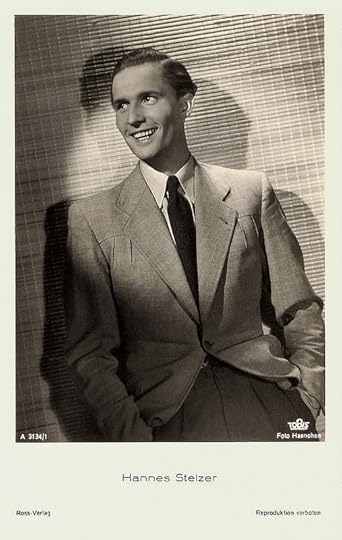
German postcard by Ross-Verlag, no. A 3134/1, 1939-1940. Photo: Haenchen / Tobis.
The Idea of a Courageous Hero
Hannes Stelzer’s looks corresponded to the German ideas of a courageous hero and he celebrated great successes as a tightrope walker in Truxa (Hans H. Zerlett, 1936) opposite La Jana , and as Wolfgang Amadeus Mozart in Eine kleine Nachtmusik/A Little Night Music (Leopold Hainisch, 1939).
Jan Onderwater at IMDb is not impressed by his performance in Truxa: “Blond haired Hannes Stelzer is a kind of vaudeville-Siegfried staring as if he is constantly amazed at appearing in this film at all; he was right.”
Other popular films were Der Herrscher/The Ruler (Veit Harlan, 1937) in which he played the son of a great industrialist (again Emil Jannings ), the Fyodor Dostoevsky adaptation Der Spieler/The Gambler (Gerhard Lamprecht, 1938) starring Lida Baarová and Albrecht Schoenhals , and in the German version of the French-German circus drama Les gens du voyage/Fahrendes Volk/Travelling People (Jacques Feyder, 1938) in which he played the son of Hans Albers and Françoise Rosay .
With the outbreak of the Second World War, Stelzer could make less films. He was a pilot in Germany's Luftwaffe and between film roles took on combat missions.
Still he played starring roles, such as a Luftwaffe pilot in the propaganda film Stukas (1941). Director of the film was Luftwaffe Major Karl Ritter and the two worked five times together. The first had been the WWI epic Unternehmen Michael/Enterprise Michael (1937), followed by Bal Paré (1940) and Über alles in der Welt (1941).
Stelzer’s final film role was in Ritter's propaganda film Besatzung Dora/The Crew of the Dora (Karl Ritter, 1943), which finished filming in January 1943. In March of that year the film was banned from being released because scenes shot on the Leningrad front, in North Africa, and in western France could not be used, as German defeats and problems on the war fronts made the film untenable.
Around Christmas 1944, Hannes Stelzer died in a plane crash at the Eastern front near Komárom in Hungary. According to Wehrmacht reports, he crashed when he flew in a snowstorm in a high-voltage line, but probably his plane was shot down by the Soviets.
Hannes Stelzer was married with the actress Mary Bard, who had died shortly before him.

German postcard by Ross-Verlag, no. A 2696/1, 1939-1940. Photo: Haenchen / Tobis.

German postcard by Das Programm von Heute, Berlin / Ross-Verlag. Photo: Bavaria-Filmkunst.
Sources: Hal Erickson (AllMovie), Jan Onderwater (IMDb), German Films Poster Collection, Wikipedia (German), and .

German postcard by Film-Foto-Verlag, no. G 215, 1941-1944. Photo: Baumann.
Handsome Rising Film Star
Hannes Stelzer was born in Graz, Austria in 1910. He was the eldest son of poor, travelling actors. Hannes often had to change schools because of the profession of his parents.
He had his first theatre experience in Mühlhausen in Thuringia, when his mother proposed her son for a children's dance scene in the operetta Die Fledermaus (The Bat). On his own initiative he applied successfully for the Vienna drama school at the age of fourteen. He lived in Vienna at the house of an uncle and earned the money for his studies as a carpenter.
Srelzer made his stage debut as the old Klinkert in Hasemanns Töchter by Adolph L’Arronge, but did it as a volunteer. In 1928 he received his first engagement at the Neues Theater (New Theatre) in Frankfurt am Main, and moved in 1931 to Bremen.
Here Stelzer played Romeo, but he also had parts in modern plays. After three years, Stelzer got an engagement in Darmstadt at the Landestheater (National Theatre), where he could play the great classical roles.
In 1935 he was considered for the role of the young Friedrich (Frederic) in the biopic Der junge und alte König/The Young and the Old King (Hans Steinhoff, 1935) with famous actor-producer Emil Jannings as his father. After first committing to the role, he eventually declined it in order to take up another stage engagement.
However, Emil Jannings was impressed by Stelzer and got him a role as a student of professor Traumulus (Jannings) in the film Traumulus/The Dreamer (Carl Froelich, 1935). Hal Erickson at AllMovie : “Keeping his tendency to overact in check, Emil Jannings delivers one of his best and subtlest performances in this film.”
After that, Stelzer’s activity shifted more and more to the cinema. The handsome rising film star played in comedies, costume dramas, and sophisticated contemporary films and quickly became a popular Ufa star.

German postcard by Ross-Verlag, no. A 1882/1, 1937-1938 (signed in 1939). Photo: Sandau, Berlin / Tobis.

German postcard by Ross-Verlag, no. A 3134/1, 1939-1940. Photo: Haenchen / Tobis.
The Idea of a Courageous Hero
Hannes Stelzer’s looks corresponded to the German ideas of a courageous hero and he celebrated great successes as a tightrope walker in Truxa (Hans H. Zerlett, 1936) opposite La Jana , and as Wolfgang Amadeus Mozart in Eine kleine Nachtmusik/A Little Night Music (Leopold Hainisch, 1939).
Jan Onderwater at IMDb is not impressed by his performance in Truxa: “Blond haired Hannes Stelzer is a kind of vaudeville-Siegfried staring as if he is constantly amazed at appearing in this film at all; he was right.”
Other popular films were Der Herrscher/The Ruler (Veit Harlan, 1937) in which he played the son of a great industrialist (again Emil Jannings ), the Fyodor Dostoevsky adaptation Der Spieler/The Gambler (Gerhard Lamprecht, 1938) starring Lida Baarová and Albrecht Schoenhals , and in the German version of the French-German circus drama Les gens du voyage/Fahrendes Volk/Travelling People (Jacques Feyder, 1938) in which he played the son of Hans Albers and Françoise Rosay .
With the outbreak of the Second World War, Stelzer could make less films. He was a pilot in Germany's Luftwaffe and between film roles took on combat missions.
Still he played starring roles, such as a Luftwaffe pilot in the propaganda film Stukas (1941). Director of the film was Luftwaffe Major Karl Ritter and the two worked five times together. The first had been the WWI epic Unternehmen Michael/Enterprise Michael (1937), followed by Bal Paré (1940) and Über alles in der Welt (1941).
Stelzer’s final film role was in Ritter's propaganda film Besatzung Dora/The Crew of the Dora (Karl Ritter, 1943), which finished filming in January 1943. In March of that year the film was banned from being released because scenes shot on the Leningrad front, in North Africa, and in western France could not be used, as German defeats and problems on the war fronts made the film untenable.
Around Christmas 1944, Hannes Stelzer died in a plane crash at the Eastern front near Komárom in Hungary. According to Wehrmacht reports, he crashed when he flew in a snowstorm in a high-voltage line, but probably his plane was shot down by the Soviets.
Hannes Stelzer was married with the actress Mary Bard, who had died shortly before him.

German postcard by Ross-Verlag, no. A 2696/1, 1939-1940. Photo: Haenchen / Tobis.

German postcard by Das Programm von Heute, Berlin / Ross-Verlag. Photo: Bavaria-Filmkunst.
Sources: Hal Erickson (AllMovie), Jan Onderwater (IMDb), German Films Poster Collection, Wikipedia (German), and .
Published on February 27, 2014 23:00
Paul van Yperen's Blog
- Paul van Yperen's profile
- 13 followers
Paul van Yperen isn't a Goodreads Author
(yet),
but they
do have a blog,
so here are some recent posts imported from
their feed.



